Bernina Express Train: Guide to Switzerland’s Most Scenic Railway
This guide shows what a train ride on the Bernina Express between Tirano and Chur is like and offers practical information and tips to help you make the most of your journey.
Taking the Bernina Express
Of all Switzerland’s scenic train journeys, the narrow-gauge Bernina Express is arguably the most famous.
Chances are that you have come across the well-known images of a Bernina Express train crossing the famous Landwasser Viaduct on social media or in tourist brochures.
However, the Landwasser Viaduct is just one of the many sights you’ll encounter when taking the Bernina Express, as the railway line boasts breathtaking scenery along its entire length.
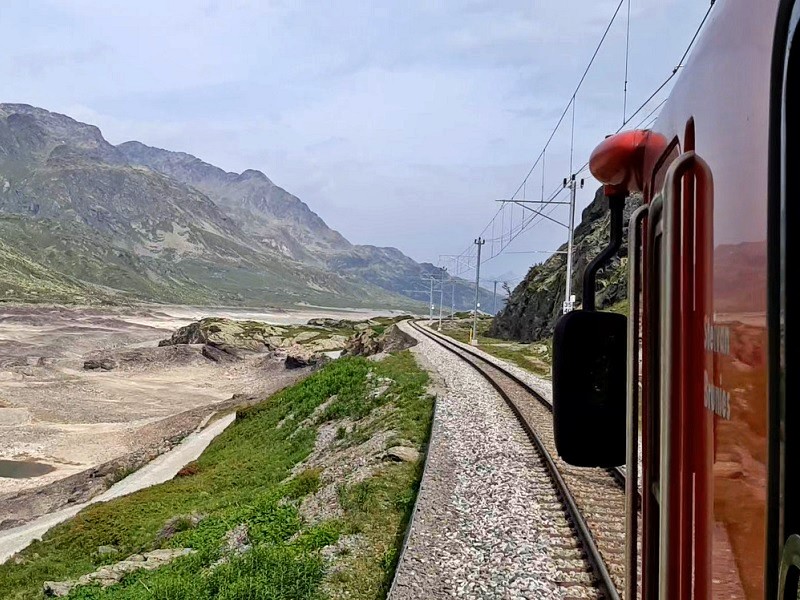

About the Bernina Express
Although tourists often think the Bernina Express is a single train, the name actually refers to the several daily express trains that operate on the narrow-gauge Bernina Railway.
This railway line crosses the Bernina mountain range, a subdivision of the Swiss Alps.
In fact, at 2,253 metres (7,392 ft) above sea level the Bernina Pass is the highest railway crossing in Europe.
The bridges, tunnels and passing loops of the line are such an astonishing piece of engineering that the Bernina Railway has even been inscribed on the UNESCO World Heritage List.
Trains on the classic Bernina Express route link Chur in Switzerland with Tirano in Italy (and vice versa, of course).
However, there are also Bernina Express trains that from the Swiss town of St. Moritz to Tirano.
Both of these trains will take you along the railway line across the Bernina Pass, but do note that if you select the shorter route between St. Moritz and Tirano you will bypass the Landwasser Viaduct, so I would strongly suggest to take one of the Bernina Express trains linking Chur with Tirano.
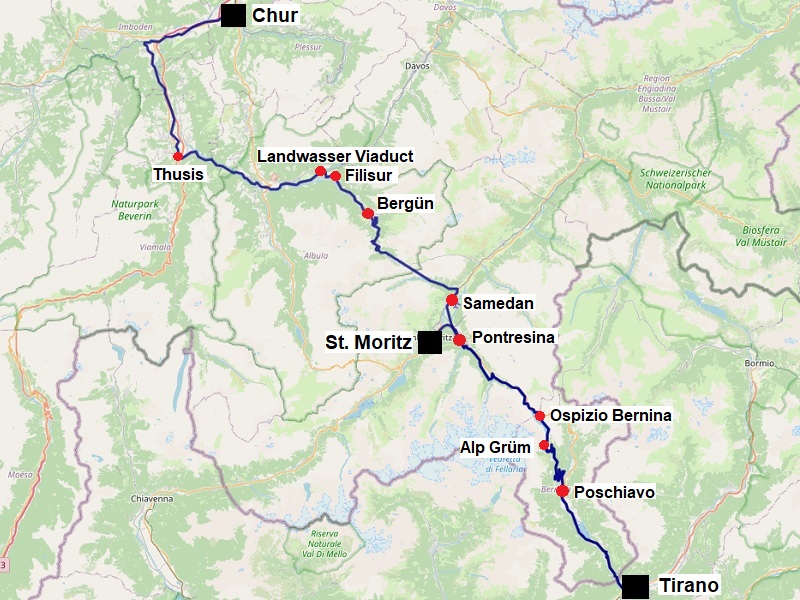
Which train to take on the Bernina Railway?
If you want to travel on the Bernina Railway you have the choice between taking the Bernina Express or one of the slower local train services.
In railway timetables the Bernina Express trains will have a train number starting with PE, which stands for Panorama Express (for example, PE 951 denotes a morning Bernina Express train from Chur to Tirano).
Local trains are designated by a train number that starts with the letter R, which stands for a Regio service (for instance, R 1636 represents a regional train service from Tirano to St. Moritz).
As is usually the case within Europe, the easiest way to access train timetables is through the excellent search engine provided by the German Railways.
Both the Bernina Express and all the local train services are operated by Swiss transport company Rhätische Bahn (Rhaetian Railway), often abbreviated as RhB.
Although the Bernina Express is highly popular among tourists visiting Switzerland, it’s important to note that it’s not just a tourist train, as quite a few locals also use it as well for their everyday transportation.
Likewise, many tourists opt for slower services instead of the Bernina Express.
Whichever train you choose to take, you’ll essentially experience the same scenery.
However, there are some differences between the Bernina Express and the local trains plying the route over the mountain pass.
The Bernina Express train is comprised of special panorama cars with large panoramic windows, and is pulled by an Allegra ABe 8/12 railcar.
Local trains on the other hand don’t have special panorama cars and take more time to complete the route as they stop at every station, and you might even have to change trains halfway.
Both the special panorama carriages of the Bernina Express and the Allegra railcar that pulls them offer seats in both first and second class.
The difference between the two classes lies in the fact that second-class has two seats abreast on each side of the aisle, while first-class carriages provide a more spacious setting with a 1-2 seating configuration.
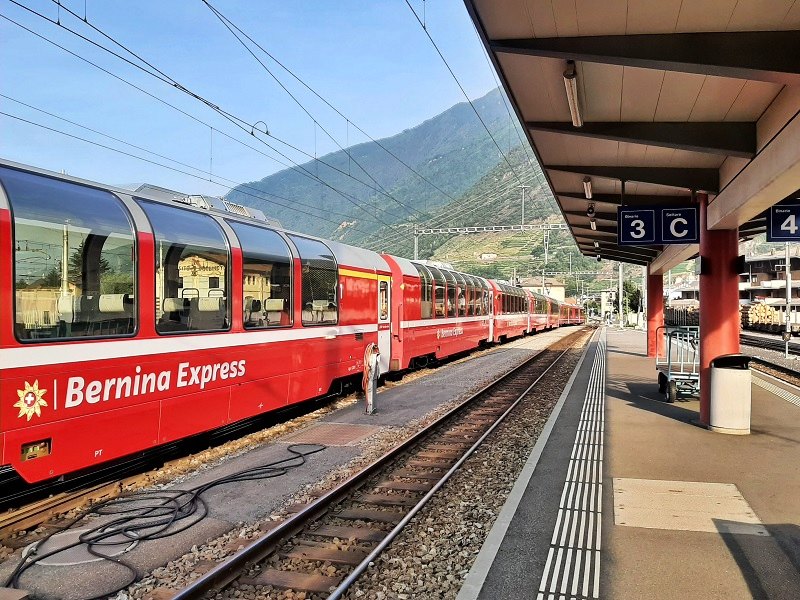

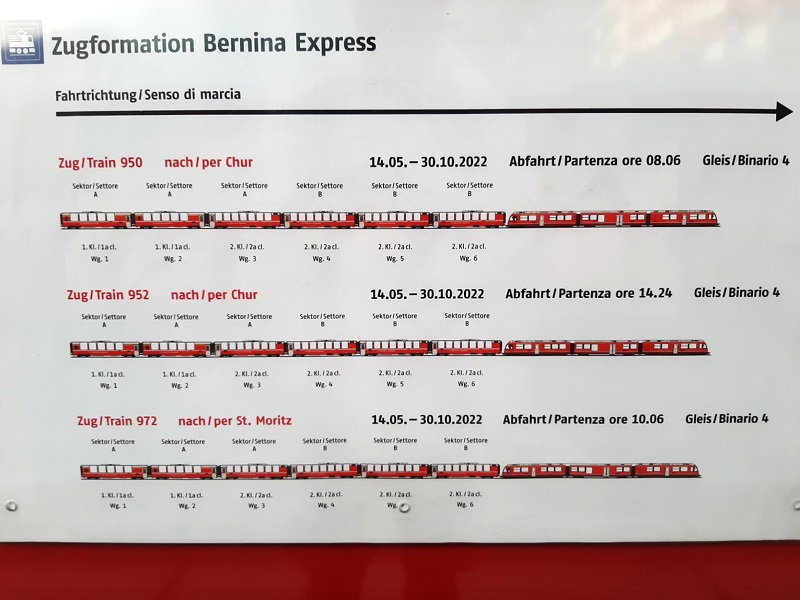
Panorama carriages
The majority of tourists who choose the Bernina Express opt for seats in the train’s panorama carriages.
With large panoramic windows, these train wagons are indeed smart-looking and allow for some great views over the Swiss scenery.
In first class, the seats are upholstered with leather and arranged in a 1-2 configuration, whereas second class seats are cloth-covered and arranged in a 2-2 configuration.
Apart from the increased comfort and space in first class, there are no significant differences between the two classes.
Seats in both first and second class have power sockets and the train is equipped with Wi-Fi internet.
Special luggage storage racks are available at the far ends of each panorama carriage for passengers traveling with large bags or suitcases.
A catering trolley offering snacks and drinks for purchase will move through carriages of both classes, although you are also free to bring your own picnic along for the ride.
To ride in one of the panorama carriages on the Bernina Express, a compulsory seat reservation is required in addition to your regular train ticket.
I’ll explain how you can make a seat reservation for the panorama carriages at the bottom of this article, where I will also take a more in-depth look at the prices for the Bernina Express and how you can book a ticket.
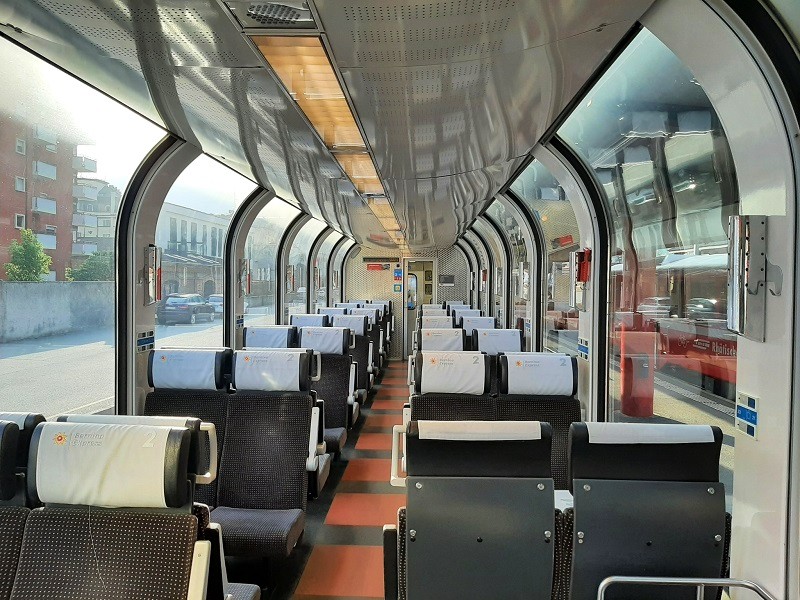

Allegra railcars
If you want to make a trip on the Bernina Express, you can also choose a seat in the Allegra railcar that hauls the train.
Similar to the panorama carriages, the seats in the Allegra railcar are arranged in a 1-2 configuration in first class, while they are positioned two abreast on each side of the aisle in second class.
All seats are equipped with power sockets, and Wi-Fi internet is also available in these train carriages.
You can place your luggage on the overhead racks which you will find in both classes.
Unlike the panorama carriages, there is no catering trolley in these Allegra railcars, so make sure you bring your own food and drinks with you.
Although the Allegra railcar lacks panoramic windows, it does feature windows that can actually be opened.
Some travellers (myself included) actually prefer the Allegra railcar because of this, as it’s much easier to make quality pictures from an open window than from a panoramic window, where dealing with glare and the reflections from other passengers inside the carriage can be a challenge.
The seats in the Allegra railcar are all unreserved, allowing you to choose any available seat you prefer when you board the train.
Especially when you board the train at one of the terminus stations (Chur, St. Moritz, or Tirano) and make sure you’re there on time at the platform, you’re likely to have a free choice of the best seats.
Another obvious advantage of travelling in the unreserved seats of the Allegra railcar is that you avoid the extra costs of the seat reservation supplement charged for the panorama carriages, while still being on the exact same Bernina Express train.
However, there is always a slight risk that no window seats are available or that the train is full and you have to stand, although this is extremely rare outside of the peak holiday months and busy weekends.

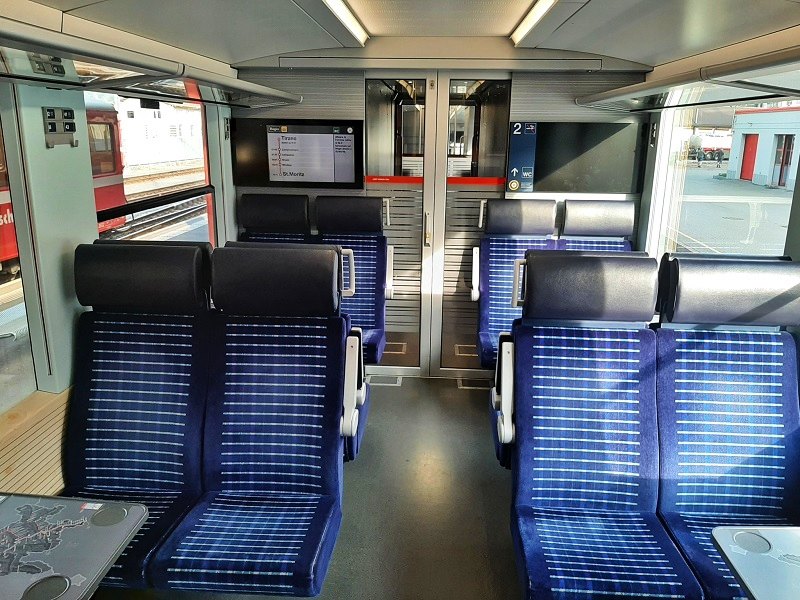
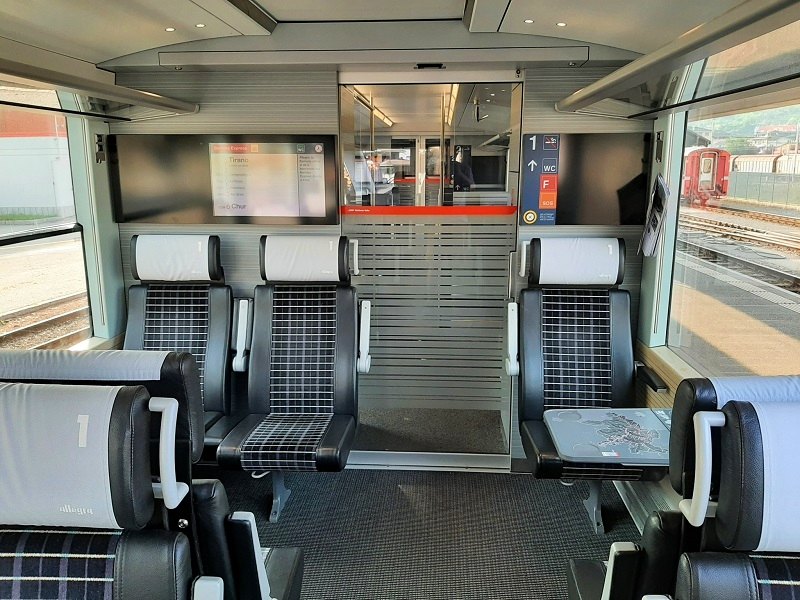
Local trains on the Bernina Railway
Numerous local trains also operate along the length of the Bernina Railway, running at much more frequent intervals than the Bernina Express.
These local trains are usually Allegra units or older-generation railcars of the Rhaetian Railway such as the ABe 4/4.
Seating on these local trains is unreserved in both second and first class, which makes them the most flexible option.
Although these local trains will be slower than the Bernina Express, they can be less crowded and more handy if you plan to make some stops along the route.

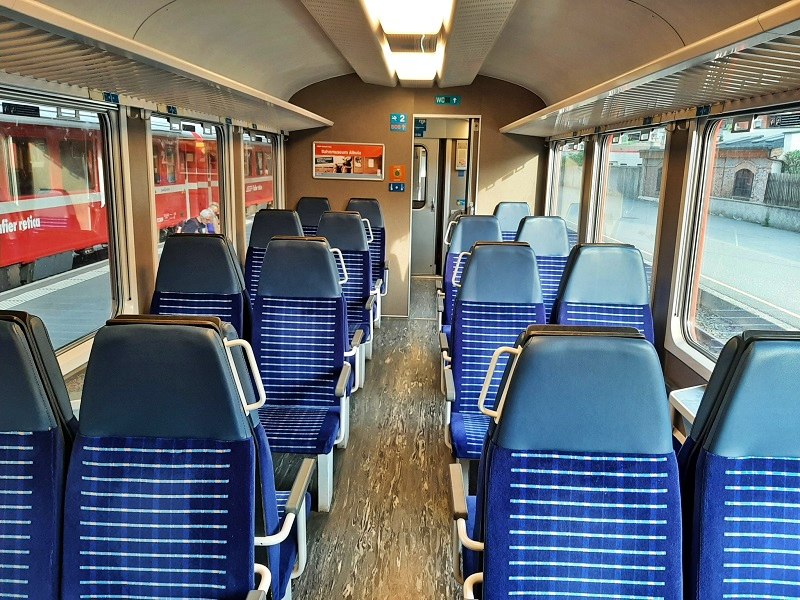

Tirano station: Start of my journey on the Bernina Express
I started my Bernina Express trip in the Italian town of Tirano, where I had arrived the evening before on the Milan-Tirano train.
Although a same-day connection to the Bernina Express in Tirano is feasible, I decided to stay the night in this northern Italian town to have a more relaxed morning without having to worry about a possible misconnection if my train from Milan would be delayed.
Bernina Express trains bound for Switzerland depart from the narrow-gauge tracks at the Rhaetian Railway station in Tirano, situated adjacent to the standard-gauge Italian station where you can catch trains to destinations along Lake Como and to Milan.
If you’re making a train connection in Tirano, all you need to do is walk across the square from the Italian station to the Swiss station.


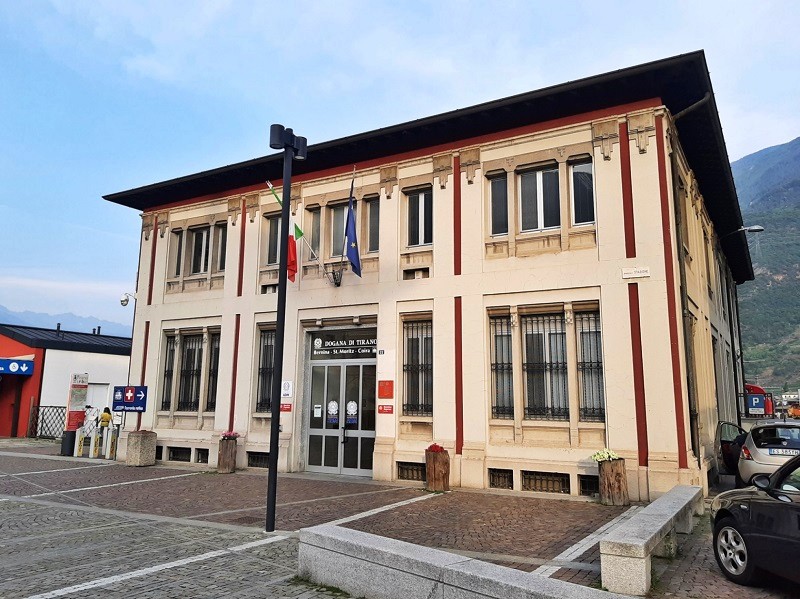
Boarding the Bernina Express
Some 20 minutes before departure, the Bernina Express train was shunted backwards into the station of Tirano.
Although there were quite some passengers in the station with reserved seats in the panorama carriages, I was the only one to board the first class section right at the front of the Allegra railcar.
I had opted for the Allegra railcar over the panorama carriage because of its windows that can actually open.
While I certainly enjoy the experience of riding in the panorama carriages, there’s nothing quite like an open window for photography and some fresh wind flowing through your hair while you partly hang out from it.
The first-class seats in the Allegra railcar are undeniably comfortable and have some superb finishing touches.
I do appreciate the table design, which includes drink holders and a map depicting the entire Rhaetian Railway network.
Large screens inside the train do not only show the next stations where it halts, but also whether the toilet in the carriage is available or not.
I took a seat on the left side of the train, as the best views are generally from this side when you’re traveling northward from Tirano to Chur.
However, as I had the entire first class section in front of the train to myself, I also opened the window on the right-hand side, which allowed me to switch sides if the best view would suddenly be at the other side.
With clear blue skies, I knew I was in for a superb train journey.
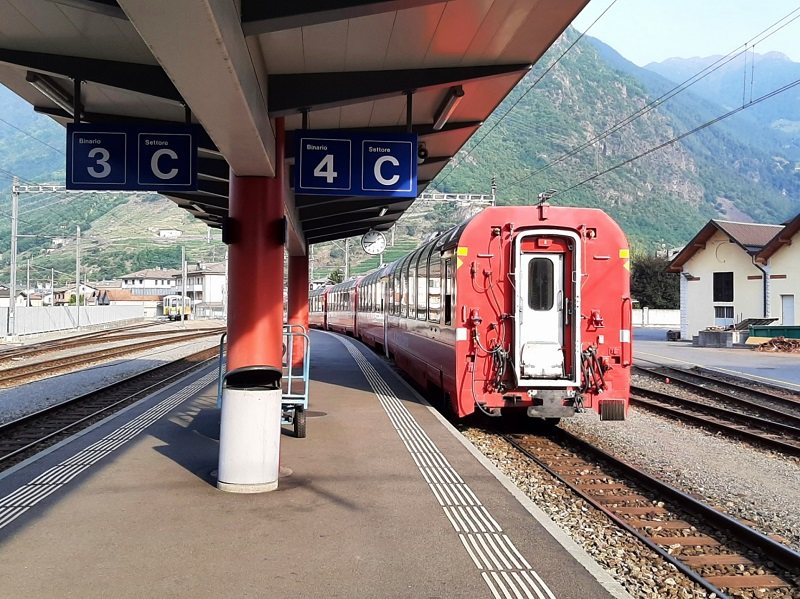


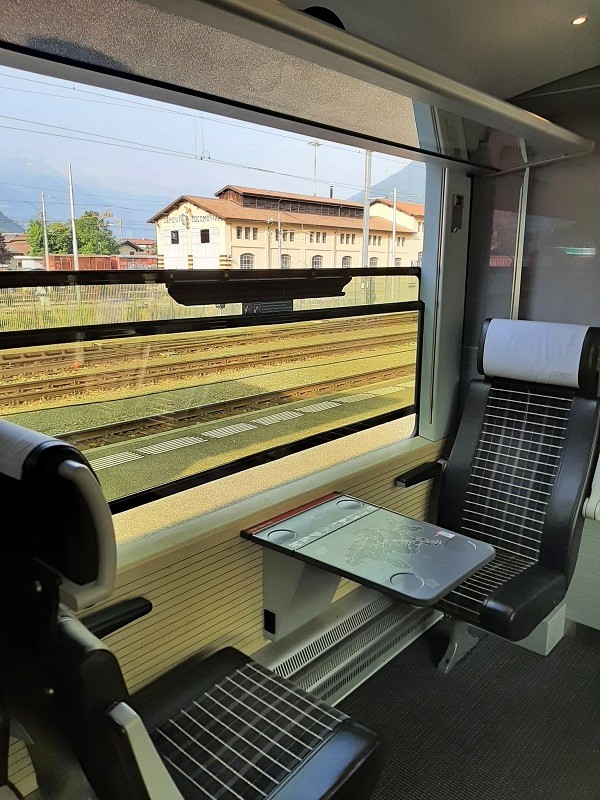
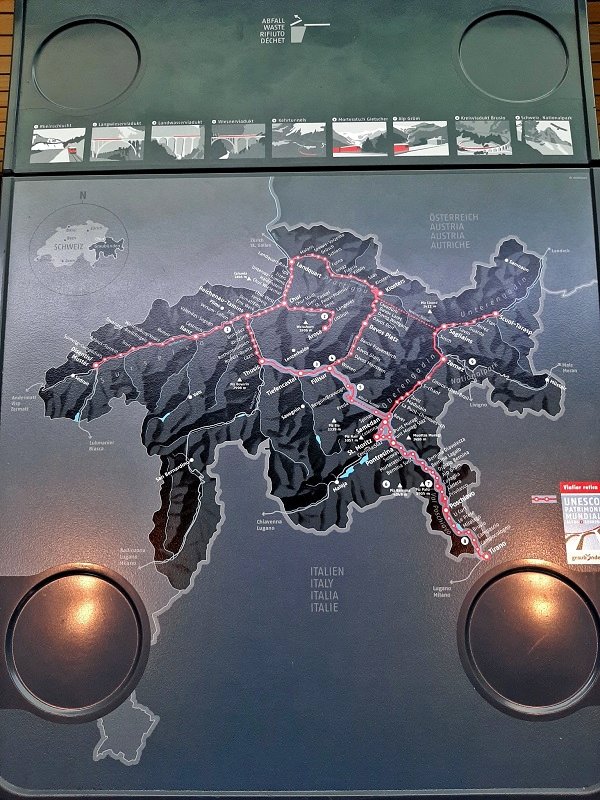

Tirano to Chur on the Rhaetian Railway ‘Bernina Express’ train
Train PE 950 – Departure: 8.06am – Arrival: 12.39pm
Duration: 4h33m – Distance: 144 kilometres
Price: Free with my 1st class Interrail pass
Through the streets of Tirano
Precisely on time, we began our 144-kilometre (89 miles) train journey from Tirano to Chur, which would take us 4 hours and 33 minutes to complete.
With an average speed of just under 32 kilometres per hour (20 mph) the Bernina Express must surely be one of the world’s slowest express trains, but given the challenging mountain landscape it has to cross that doesn’t come as a surprise.
The train will cross 55 tunnels and 196 bridges from its start in Tirano until its final stop in Chur.
The journey is spectacular right from the start, as in Tirano the railway track runs right through the town streets, literally sharing the same road with all the car traffic!
An added advantage of choosing a seat in the front first-class section of the Allegra railcar is the opportunity to enjoy perfect forward views through the cab, looking right over the train driver’s shoulder.
However, it’s worth noting that the driver can lower the blinds for privacy, so you’ll need some luck to have a train driver who doesn’t mind a few curious stares.
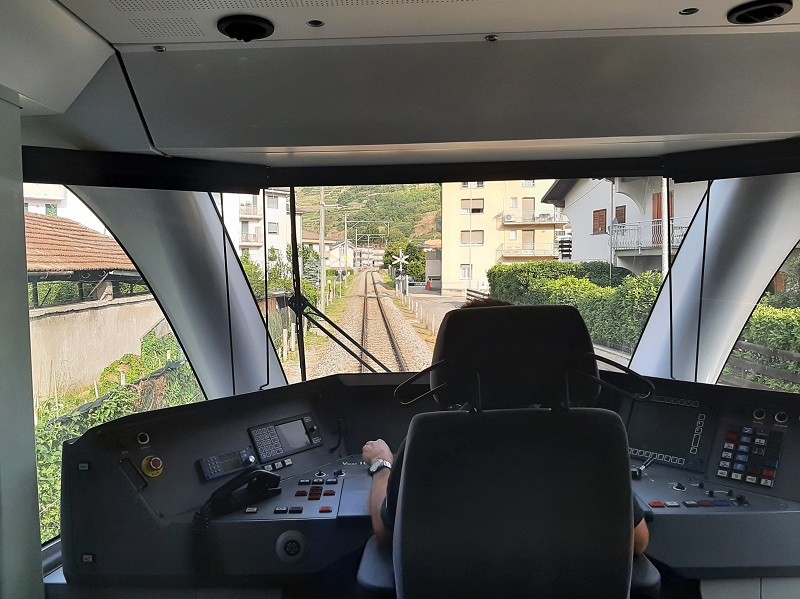


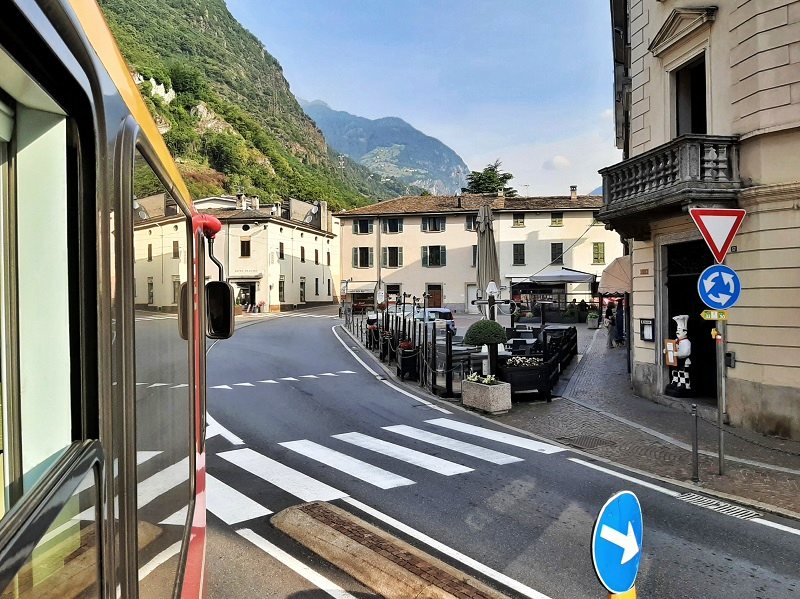


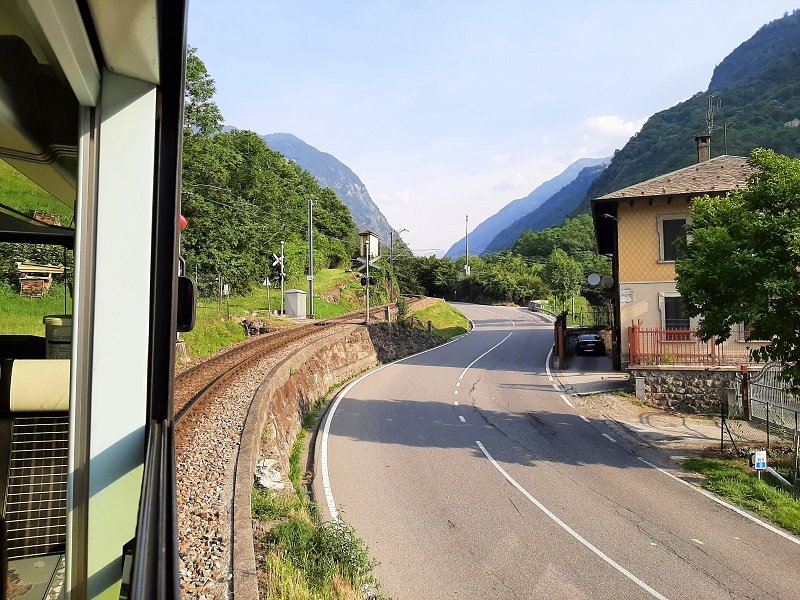
Climbing up
Leaving the town of Tirano behind, the Bernina Express will climb uphill parallel to the main road towards the Swiss border.
Our first stop was at the small station of Campocologno just across the border in Switzerland, where we had to wait for a train coming from the other direction to pass us before we could continue our way.
For the great majority of its length, the Bernina Railway is single track, which means that trains from opposite direction can only pass each other at train stations with multiple tracks or at special passing places.
Although some of these stops may appear lengthy, they have been taken into account in the timetables, so don’t automatically assume you are delayed when you are standing still for a while, as it could just be a planned stop to let another train pass.
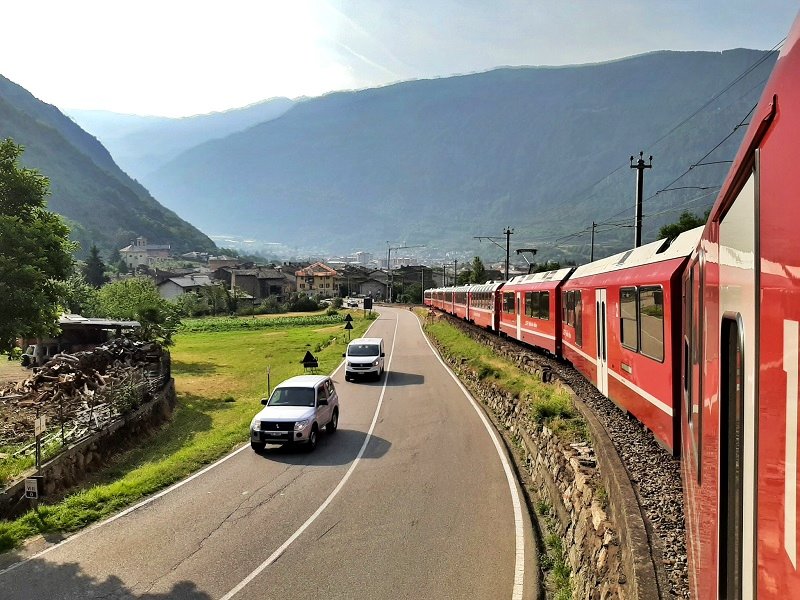
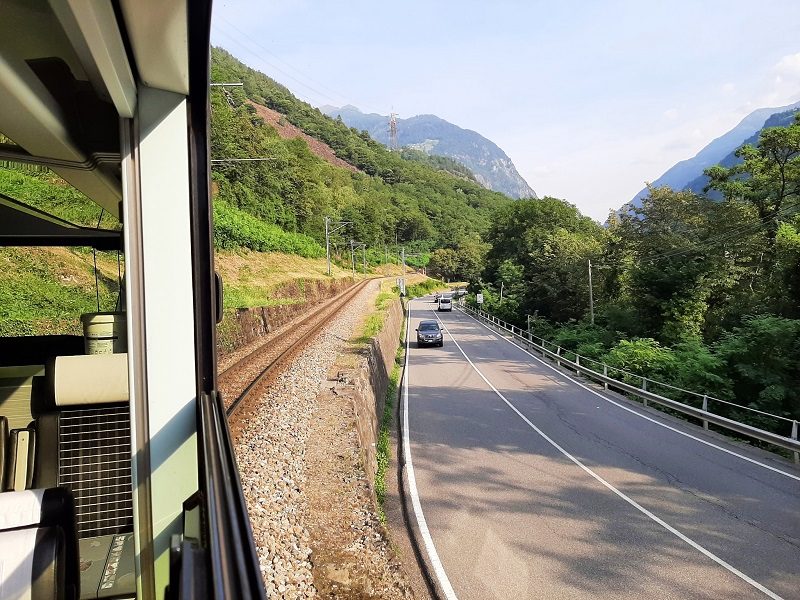
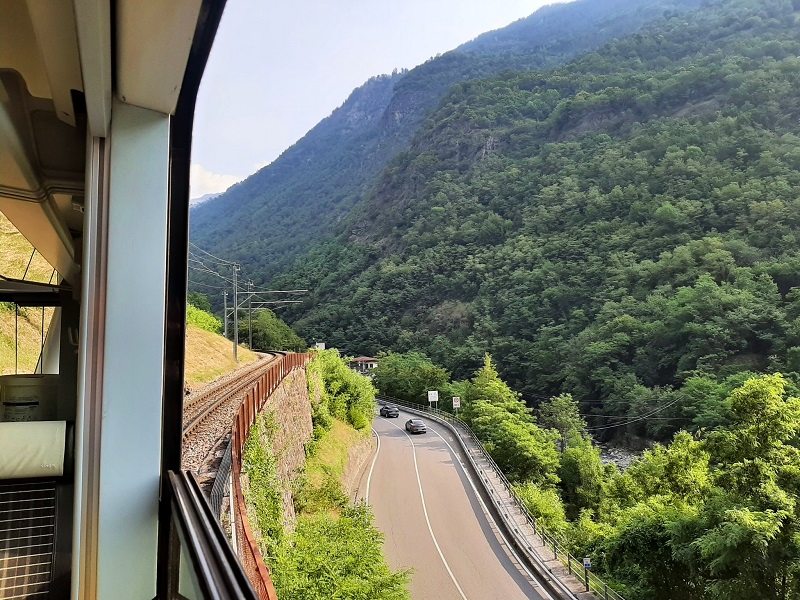
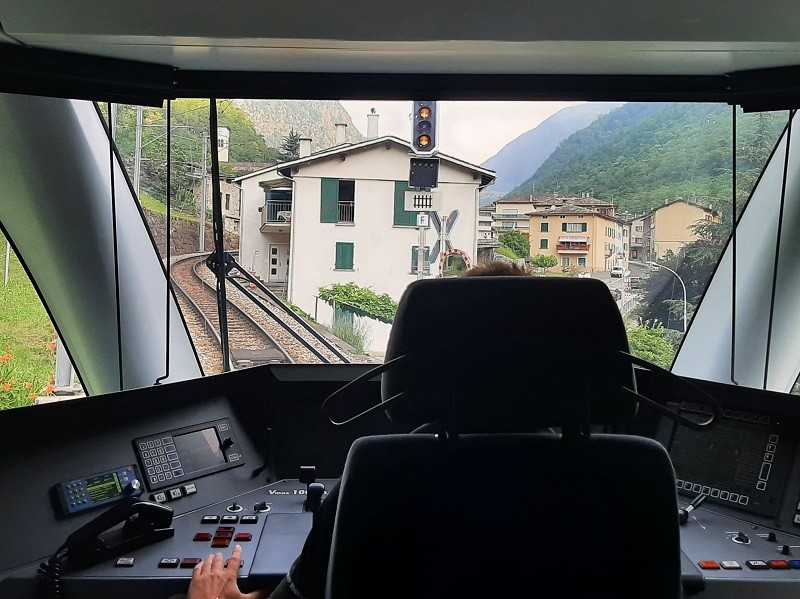

Brusio Spiral Viaduct
Just 13 minutes after departing from Tirano, the Bernina Express encounters its first major sight along the railway line in the town of Brusio.
Here, the railway line crosses the Brusio Spiral Viaduct, a stunning piece of engineering built in 1908.
The railway track gradually loops around itself in a spiral pattern on a viaduct with nine stone arches that seamlessly blends into the natural landscape
As the gradient of railway tracks cannot be too steep (it’s capped at a maximum of 7% on the Bernina Railway), such spirals were a favoured solution among Swiss engineers to overcome significant elevation differences.
It’s great fun to ride across the Brusio Spiral Viaduct on the Bernina Express.
Especially when you’re seated all the way at the front or back of the train, you get an excellent view of how your train navigates the viaduct, thanks to the sharp curve of the loop.

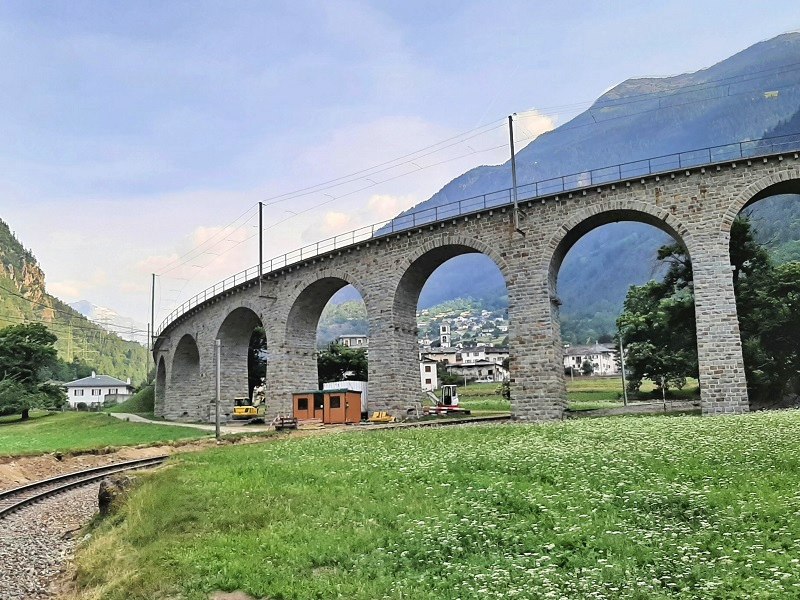

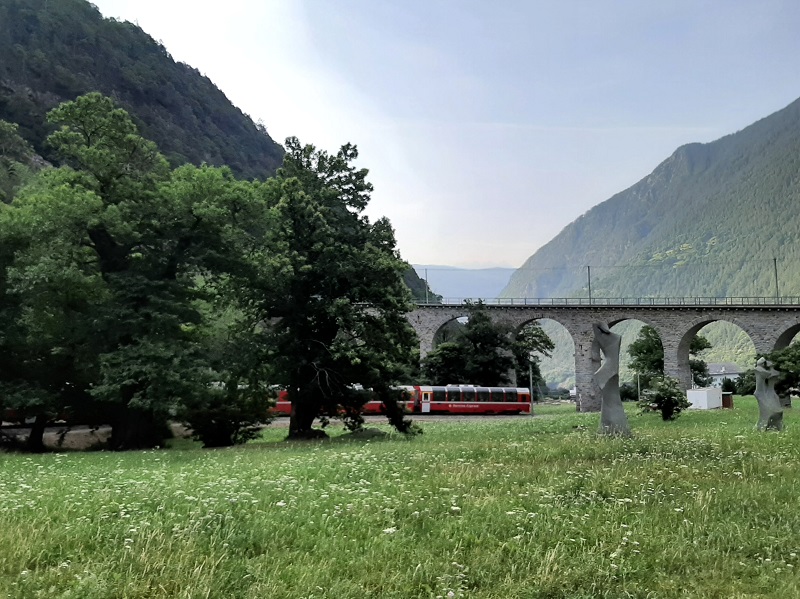

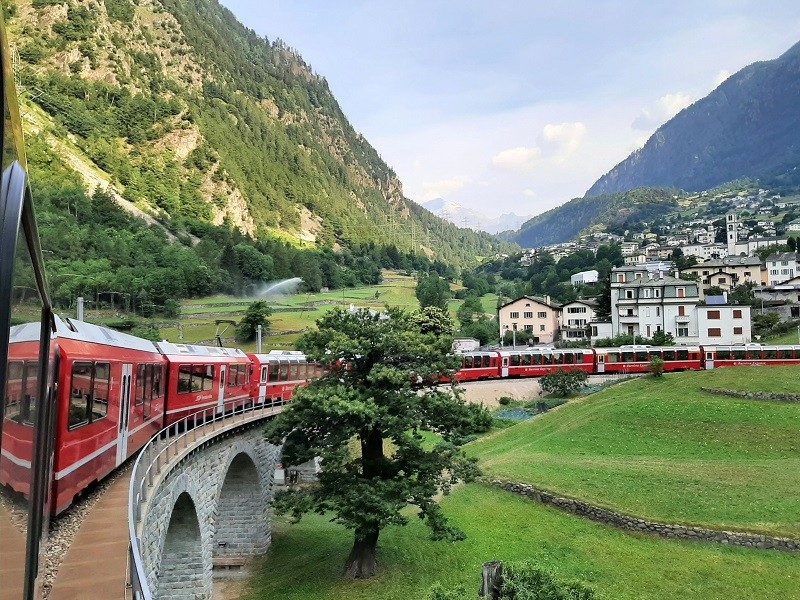


From Brusio to Lake Poschiavo
In the village of Brusio, the railway line features a series of horseshoe curves that help it gain more altitude.
If you look out of the window, you can clearly see the railway tracks the train has just traversed minutes before.
After Brusio, the Bernina Express climbs further up into the valley.
Just before the train reaches the shores of Lake Poschiavo, the railway tracks once again pass through the streets, this time in the village of Miralago.
The ride along the shores of Lake Poschiavo is pretty, and this time the best views are on the right side of the train.
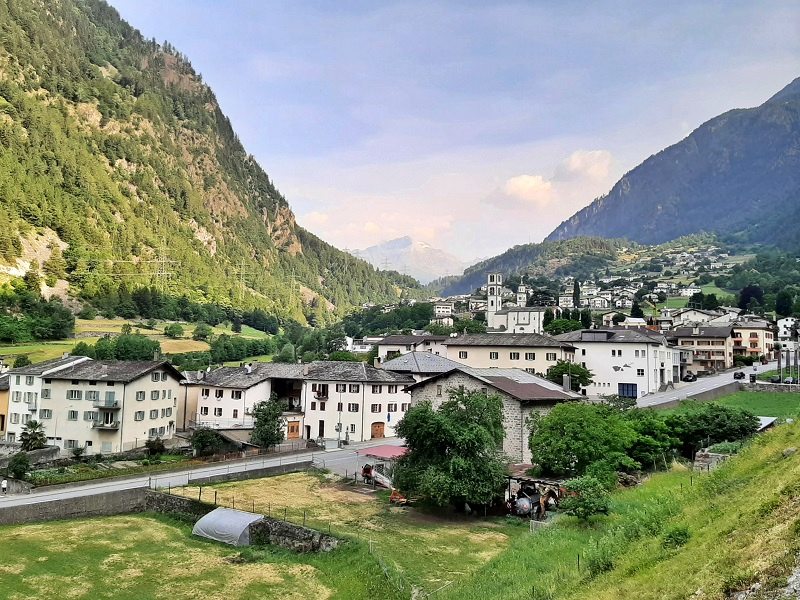
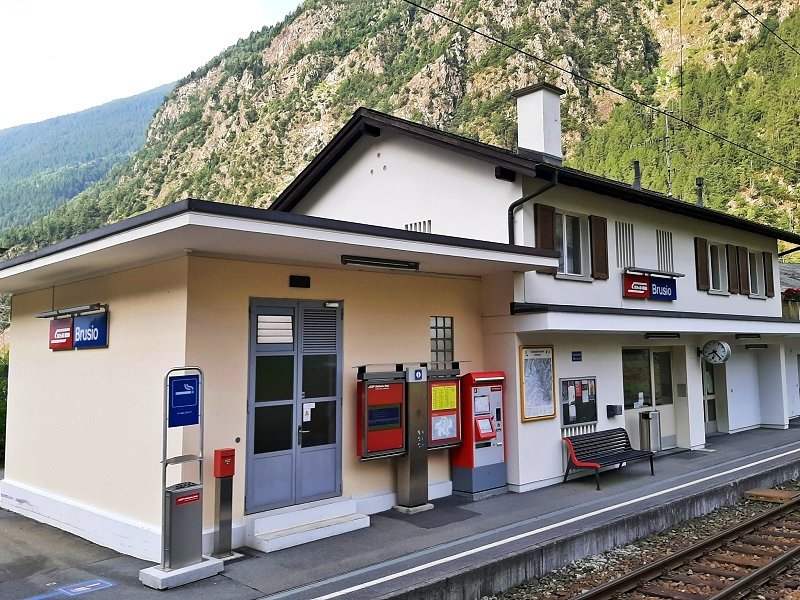

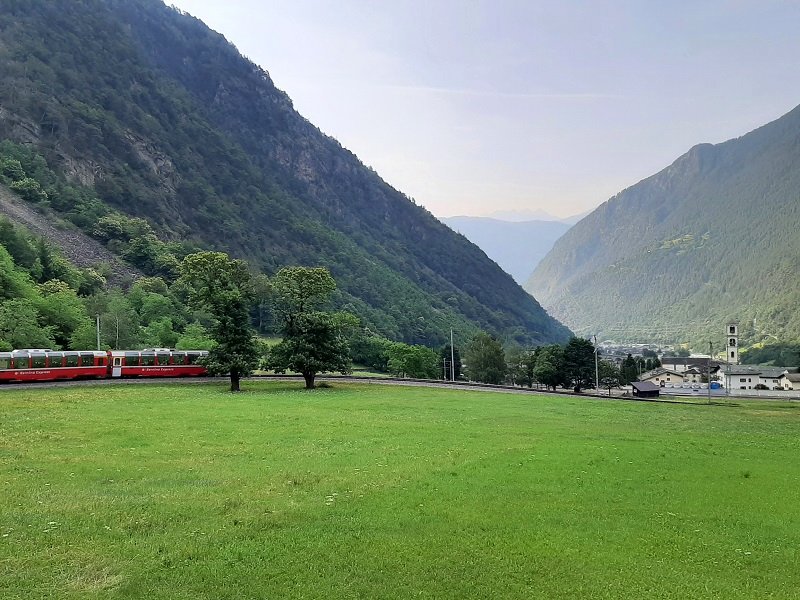
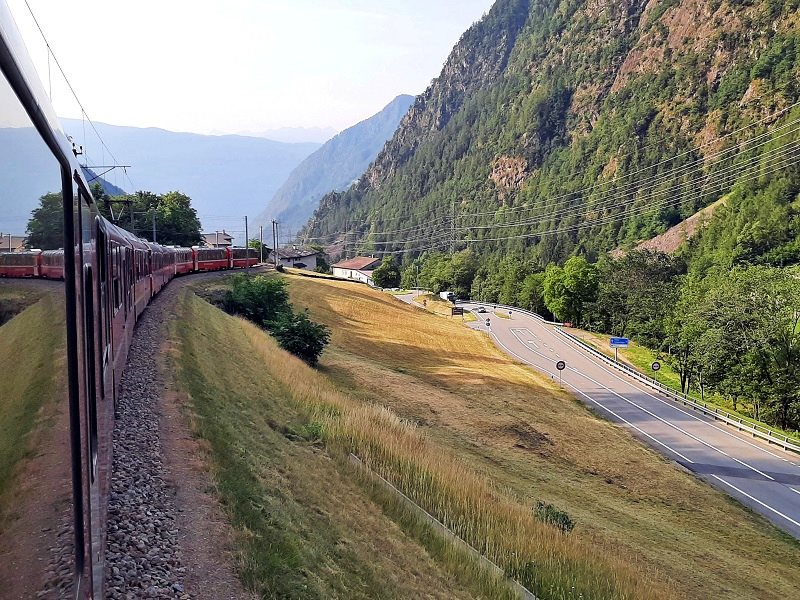



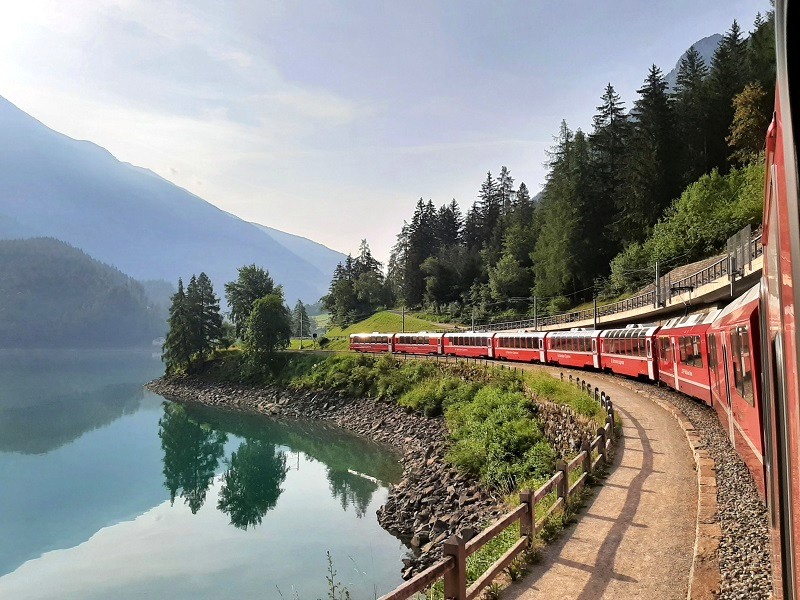

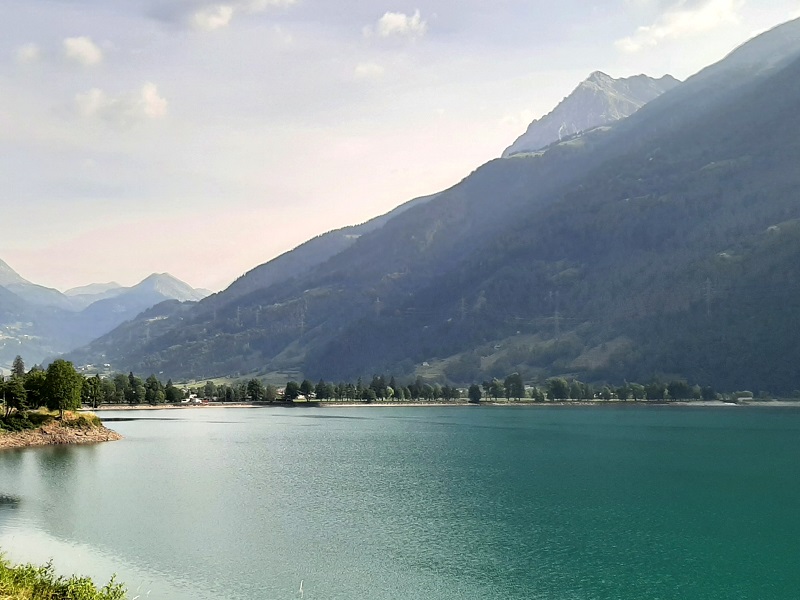

Towards Poschiavo
The railway line from the northern side of Lake Poschiavo towards the town of Poschiavo itself runs directly parallel to the main provincial road and the Poschiavino river.
In the village of Le Prese and in the south of Poschiavo, the railway line is built in the middle of the road, which the Bernina Express shares with cars, buses and lorries.
We are now in the heart of Val Poschiavo, a large valley which has Poschiavo as its main town.
Although the Italian border is already several miles behind us, the language spoken in this part of Switzerland is still Italian.
Within Switzerland, the Bernina Express exclusively travels through the trilingual Canton of Grisons (Graubünden), in which German, Romansh and Italian are spoken.
In fact, Grisons is the only canton of Switzerland where Romansh has the status of being an official language.
Once we are at the other side of the Bernina Pass, the Italian language will give way to German and Romansh, and by the time the Bernina Express has reached its final stop of Chur, German will be the predominant language.




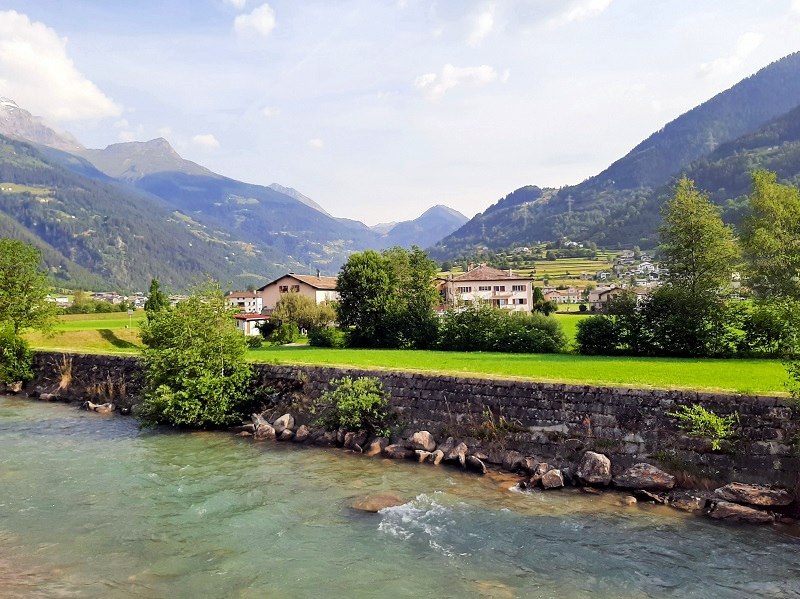


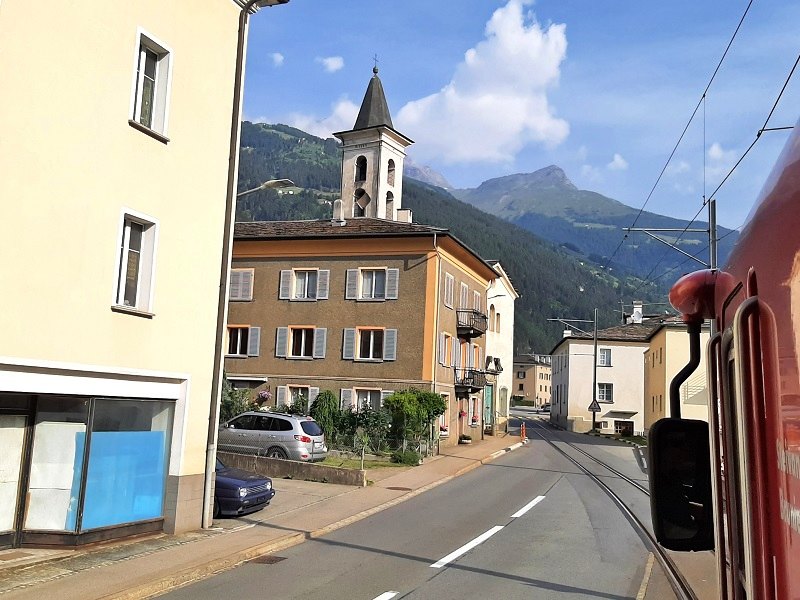

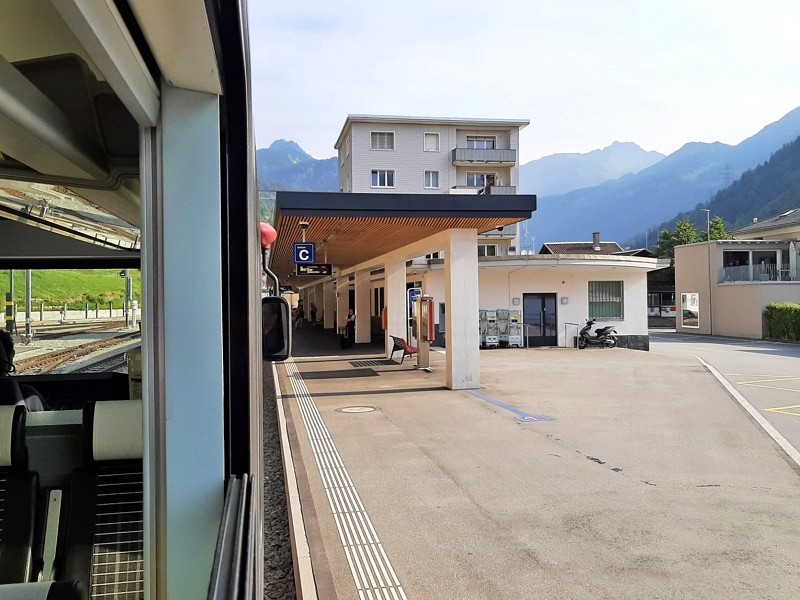
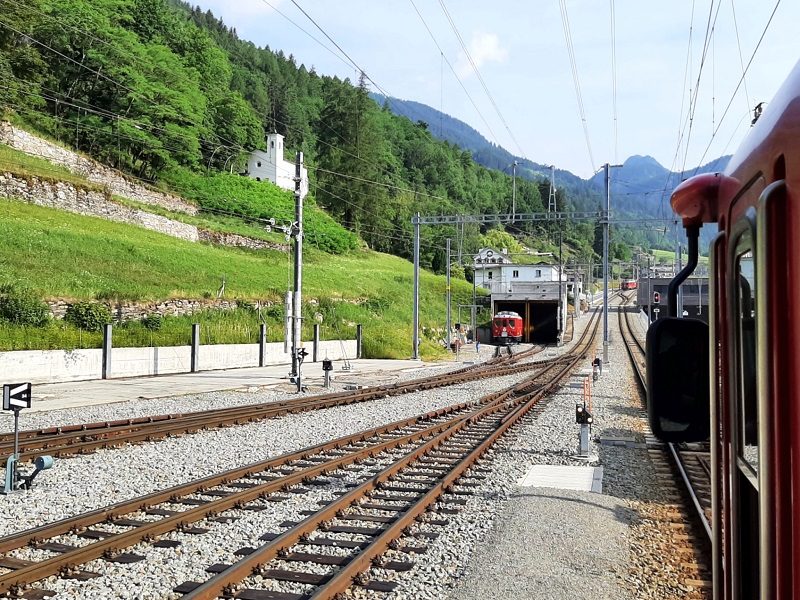
The big climb up
After the departure from Poschiavo, the Bernina Express starts the climb up towards the Bernina Pass in earnest.
The railway line runs on the western side of the Val Poschiavo and as you climb higher up on the mountainside, you are treated to increasingly more spectacular views of the valley below.





Towards Cavaglia
On its climb up from Poschiavo to Cavaglia, the Bernina Railway makes a number of horseshoe curves.
Following each horseshoe curve, the Bernina Express train essentially retraces its path along the mountainside, although at a higher altitude.
If you look carefully enough out of the window, you can see the railway tracks the train has just traversed on the lower levels of the mountainside.
Just before the Bernina Express reaches Cavaglia, the terrain levels out as the train runs through a meadow alongside a small mountain river.
At the station of Cavaglia, we had to wait a short time for a train coming from the other direction to pass by.






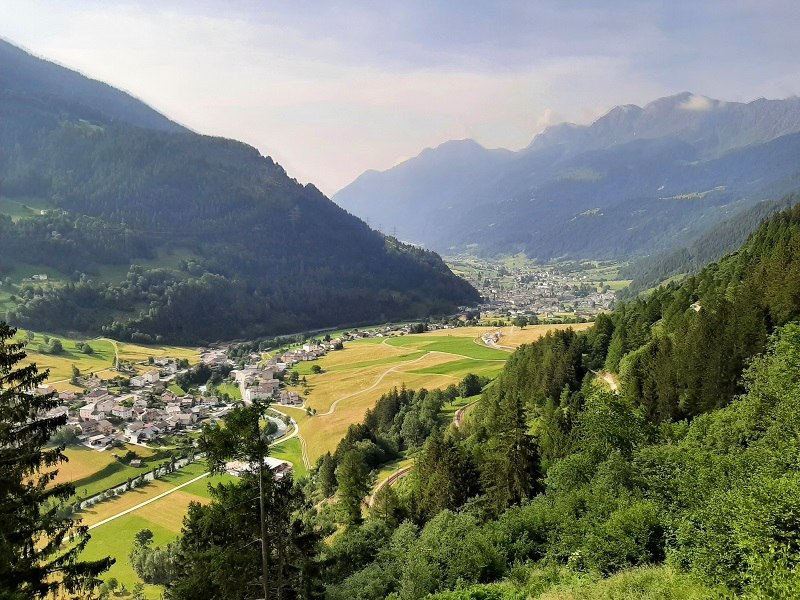
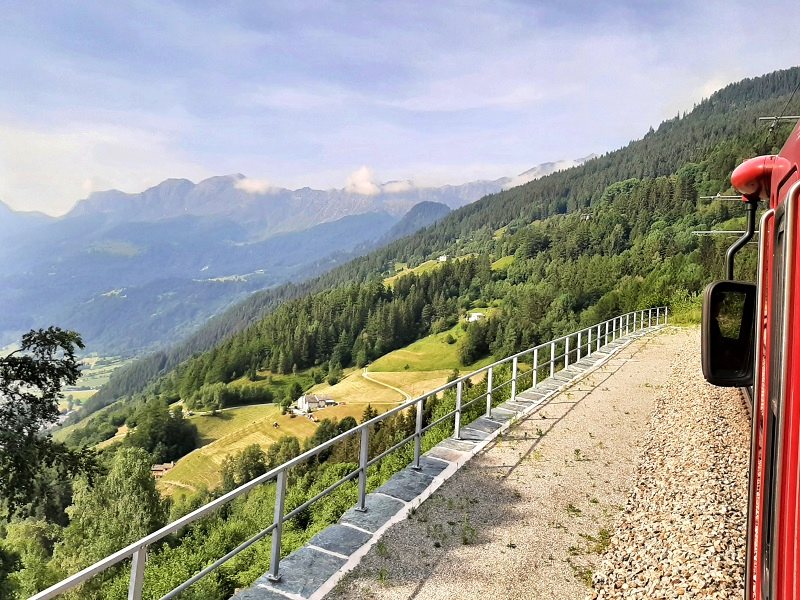
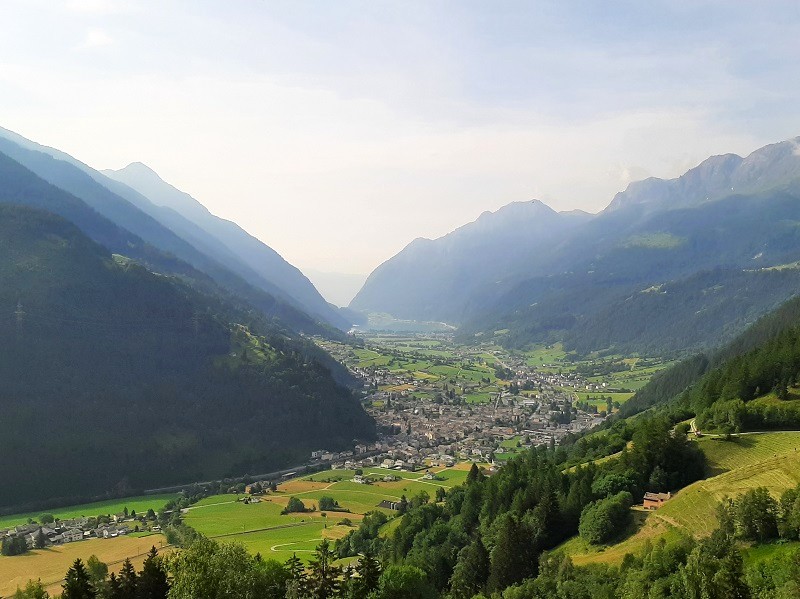
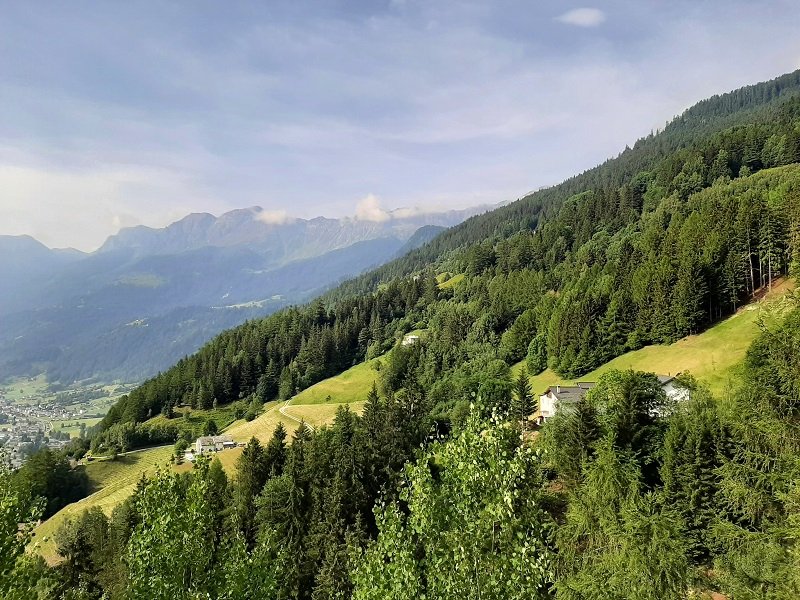



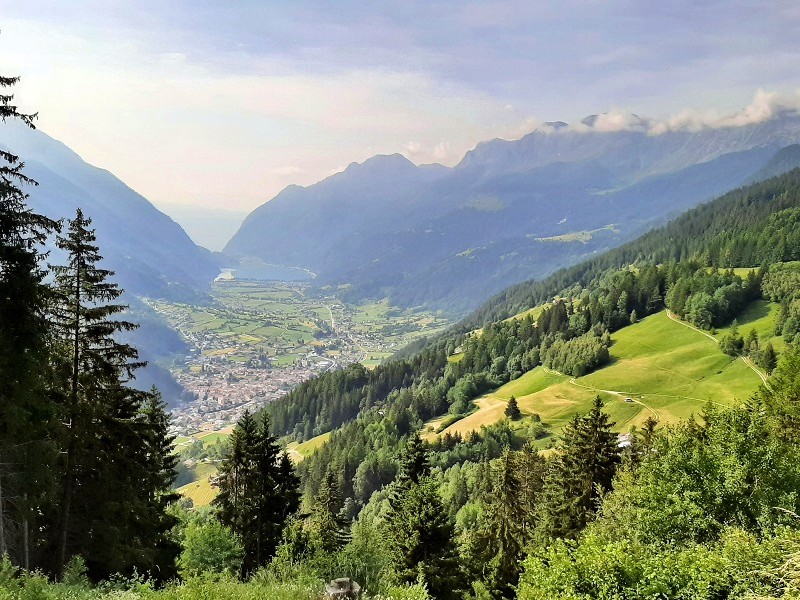
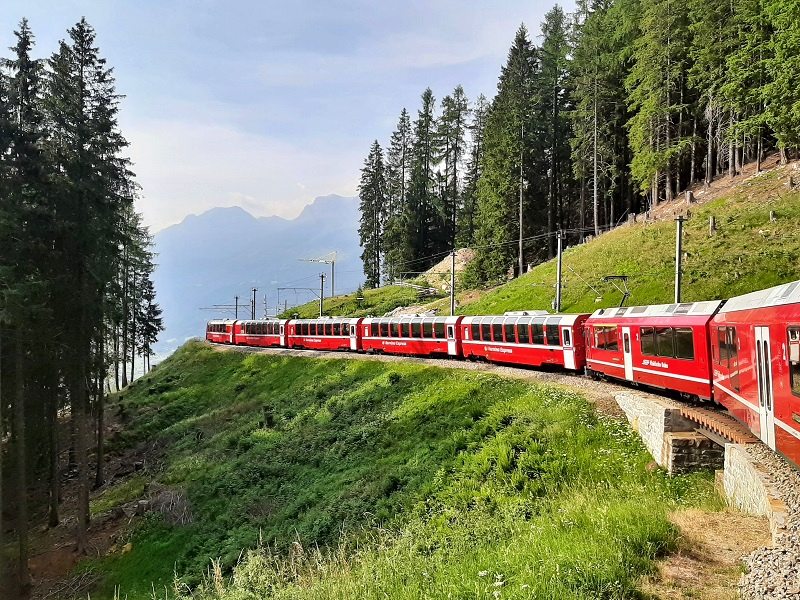


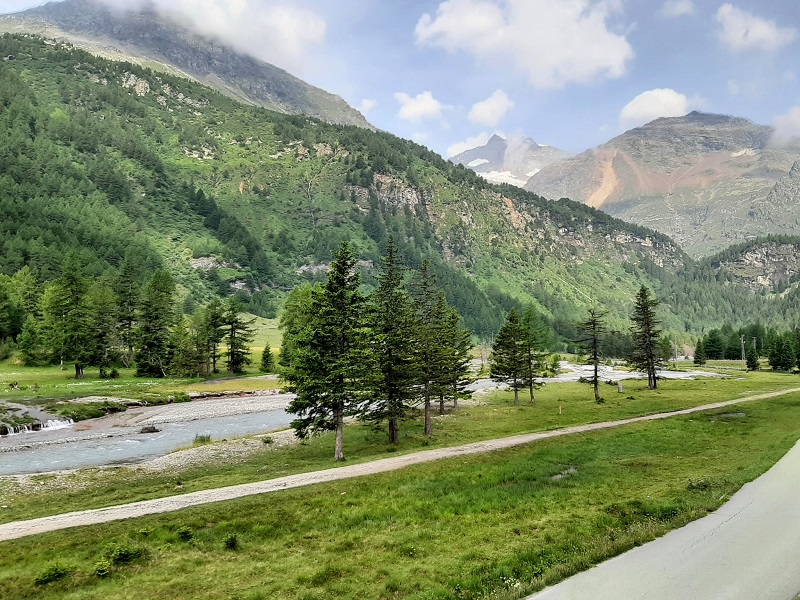

Cavaglia to Alp Grüm
Just a short while after out stop in Cavaglia, the Bernina Express train starts to climb further up the mountain.
As the train climbs higher up, not only does the scenery transform by revealing some majestic Alpine peaks, but the railway line itself also undergoes a change.
Here, the Bernina Express passes through a series of avalanche galleries, which protects the railway line from heavy snowfall and avalanches in the winter months.
With the windows wide open, I could also notice that the temperature was quite a bit cooler than it was down in the valley.
Just before the Bernina Express reaches Alp Grüm, you can are treated to some brilliant views over emerald-blue Lake Palü, nestled at the base of the majestic Palü Glacier.
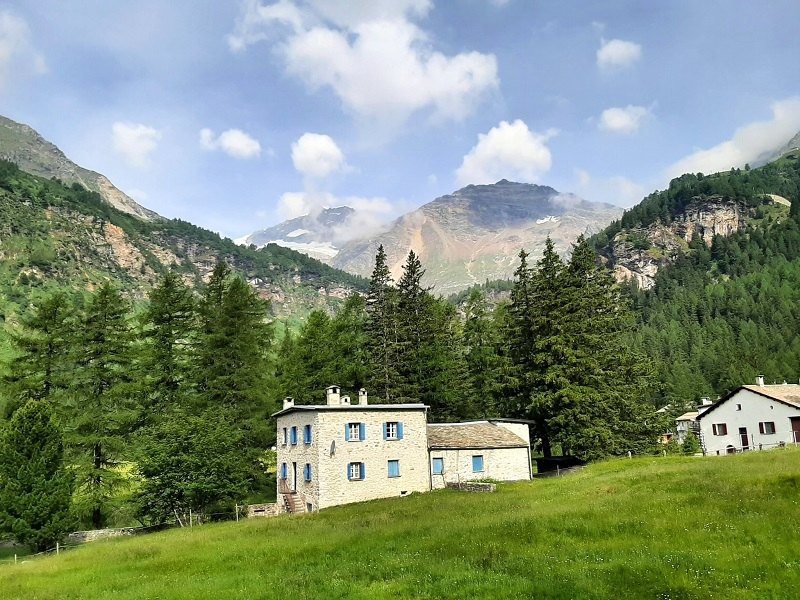

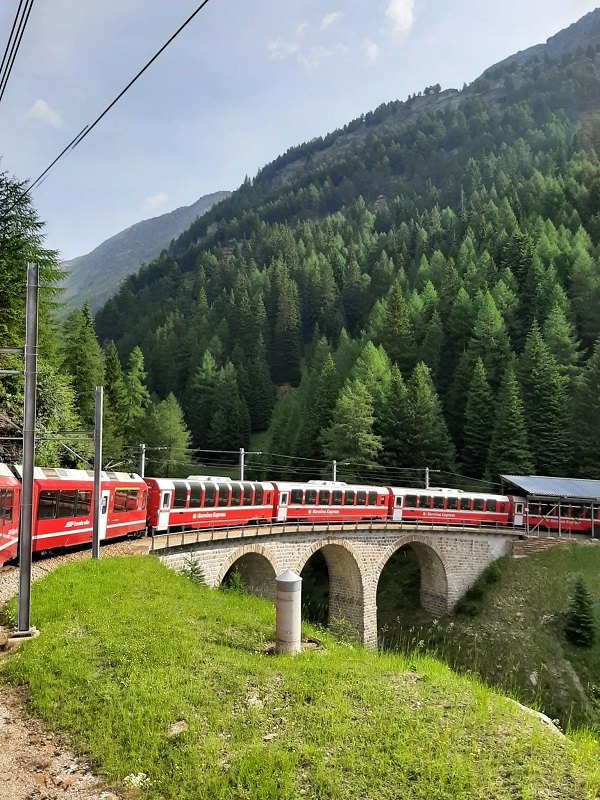


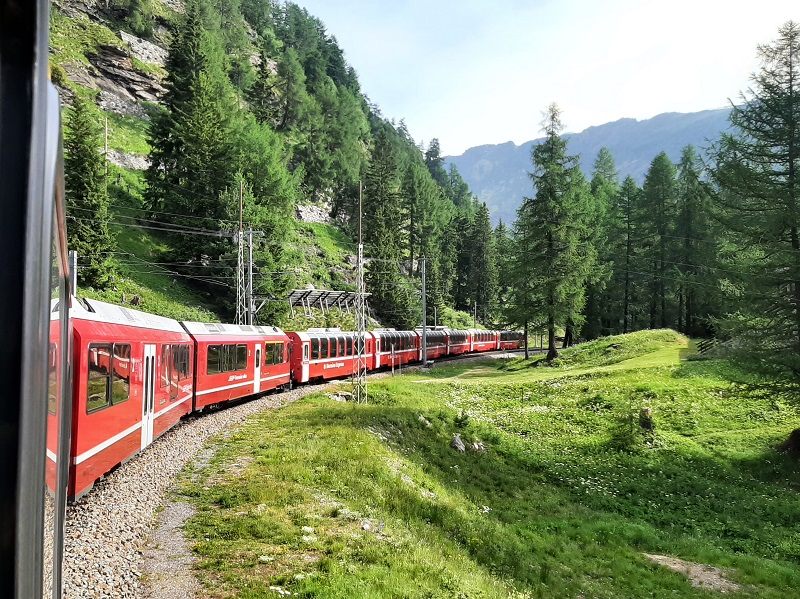
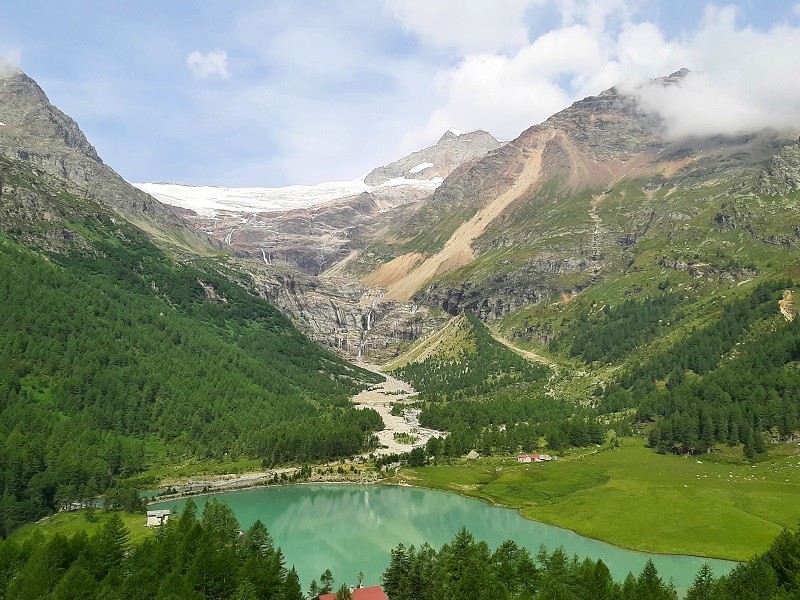

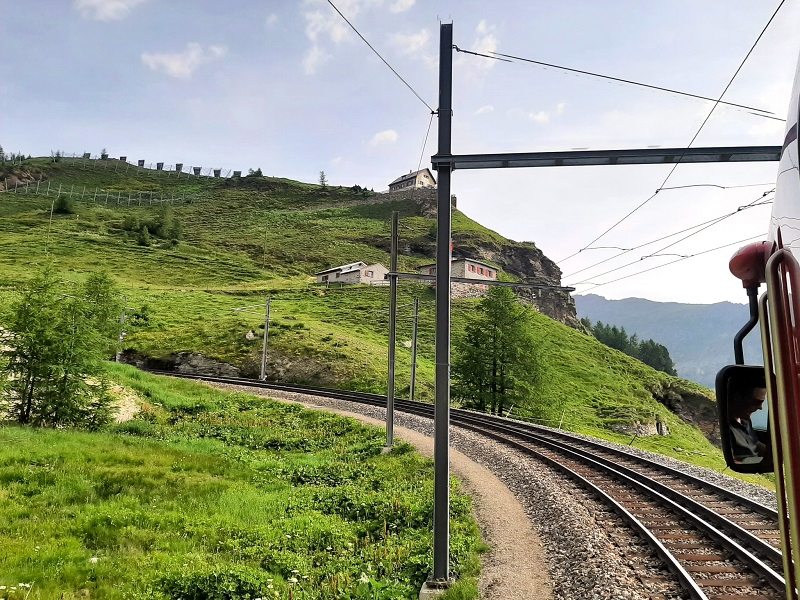

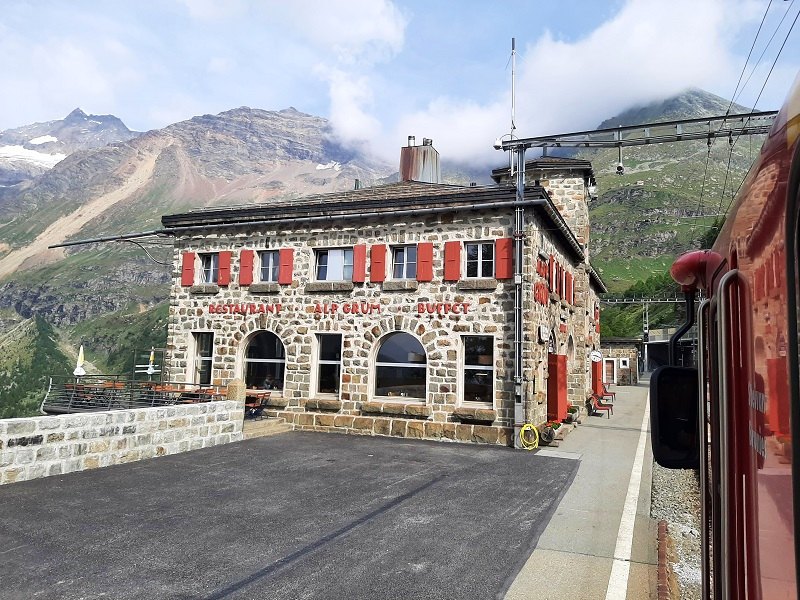
Alp Grüm
Alp Grüm is a major stop on the Bernina Railway and the Bernina Express from Tirano to Chur halts for 25 minutes here.
Although this lengthy stop was also necessited due tot the fact that we needed to wait for a train coming from the other direction to overtake us, it also give tourists on the train the opportunity to admire the beautiful panorama.
You don’t even have to step off the platform at Alp Grüm station to take in the breathtaking views of Lake Palü, the Palü Glacier and the surrounding mountain peaks.
Alp Grüm itself is a special place as you can only reach it by train or on foot, with no roads leading to this remote location.
Alp Grüm station is located at an altitude of 2,091 metres (6,860 ft) above sea level, which is more or less the treeline in this part of the Swiss Alps.
However, Alp Grüm is not the highest point on the Bernina Railway, as we will still climb higher up into the mountains after our stop at this station.
The station building of Alp Grüm doubles as a restaurant and inn, and is a popular place for tourists to spend the night, most often in combination with some hiking in the area.
If you’re just passing through on the Bernina Express and find yourself without snacks or drinks, you can purchase something at this station!
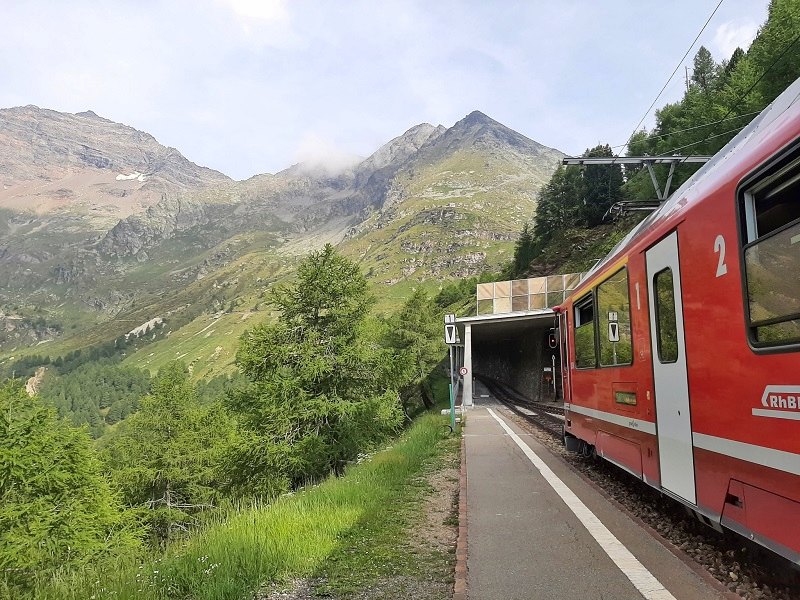



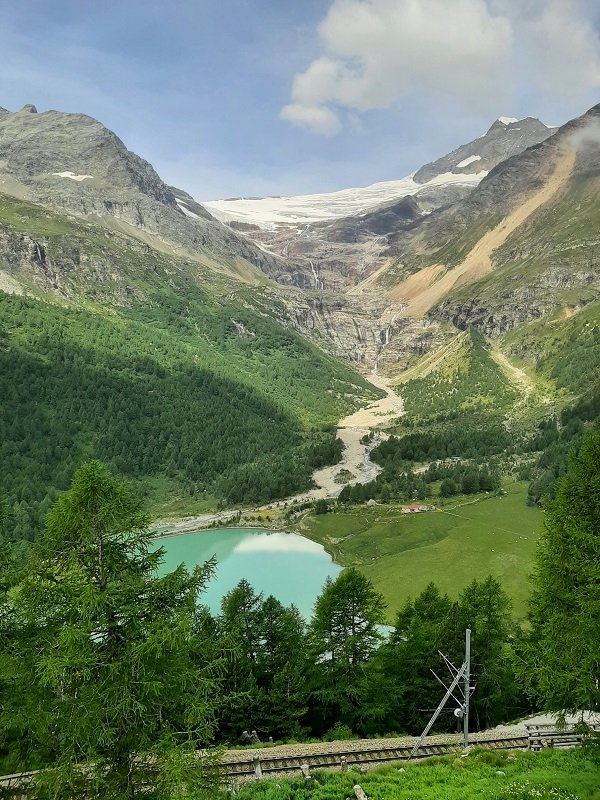



Departure from Alp Grüm
Once a southbound train had passed our Bernina Express at Alp Grüm, we were free to continue our course on the single-track railway towards the Bernina Pass.
During the stop at Alp Grüm I got into a conversation with two Indian tourists who were sitting in the second-class compartment of the Allegra railcar.
They too had the unexpected pleasure of having no other passengers around them in their part of the train, which was odd considering the panorama carriages were occupied at around 75% capacity.
Indeed, the southbound Bernina Express trains that we encountered during our journey appeared to be even more crowded than our train, giving the impression that they were all at full capacity.
We certainly were lucky on our trip!


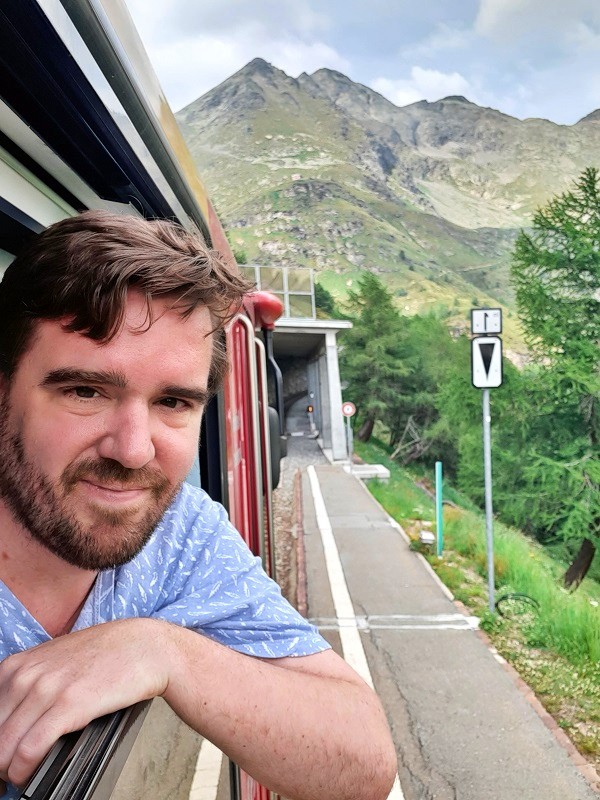
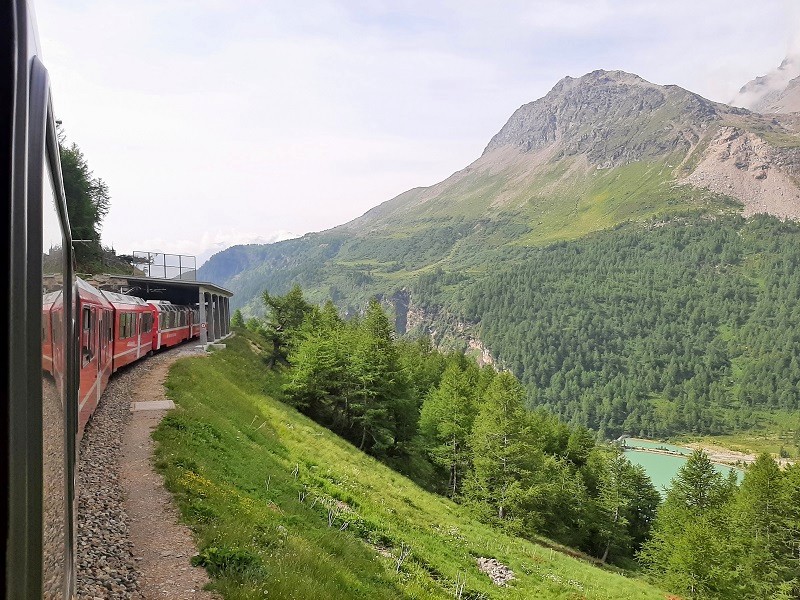
Lago Bianco
Following Alp Grüm, the Bernina Express crosses the expansive high mountain plateau of the Bernina Pass.
Due to frequent avalanches and snowdrifts in this area, numerous avalanche galleries and barriers were constructed to safeguard the Bernina Railway, enabling the year-round operation of the line.
The bleak mountain plateau is devoid of trees and is absolutely stunning in all of its wild beauty.
After a short while, the Bernina Express passes Lago Bianco (White Lake) on its left-hand side.
Lago Bianco serves as a reservoir fed by glacial meltwater, and its waters ultimately flow southward into the Mediterranean Sea through the Poschiavino, Adda, and Po rivers.




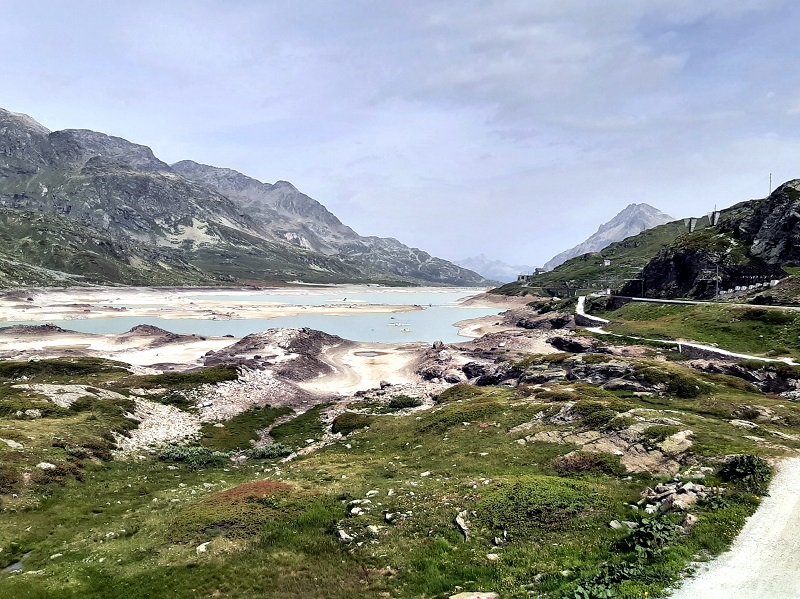
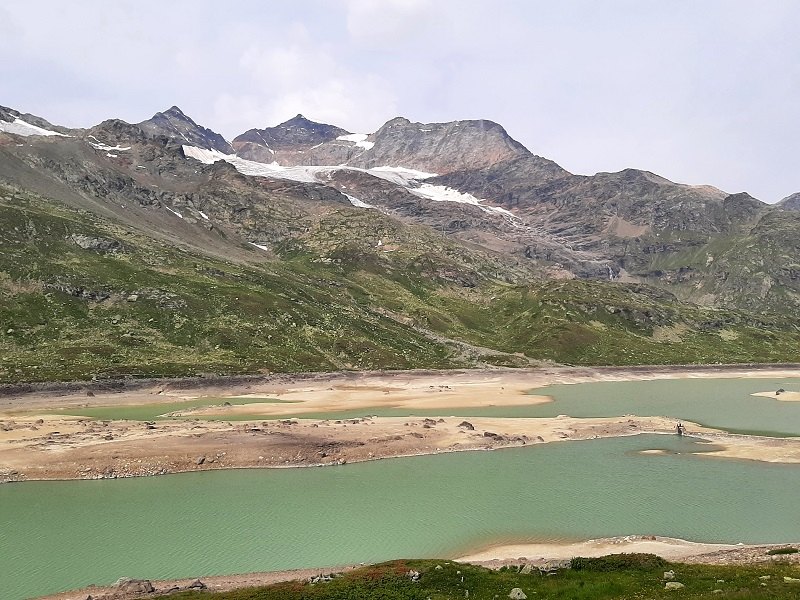
Ospizio Bernina
Another station where the Bernina Express halts is Ospizio Bernina.
Located on the eastern shore of Lago Bianco, Ospizio Bernina is the highest station on the Bernina Railway at an altitude of 2,253 metres (7,392 ft) above sea level.
The Italian word ‘Ospizio’ refers to a travellers’ inn, and it’s not surprising that one was established here, as this is the highest point of the Bernina Pass for both the railway and the adjacent road.
Once more, we had to wait for a while until a train from the opposite direction passed before we could proceed northward.
However, with the beautiful views over the cold-looking waters of the lake, this was hardly a crime.
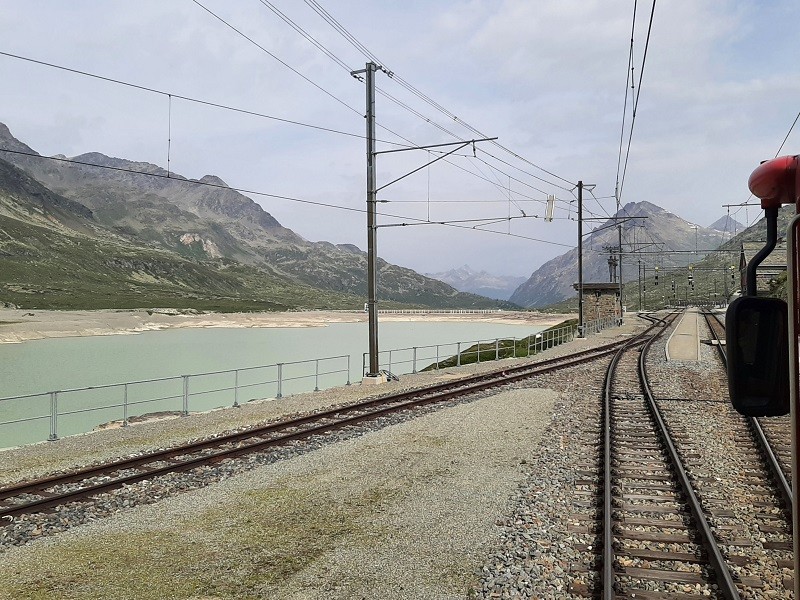
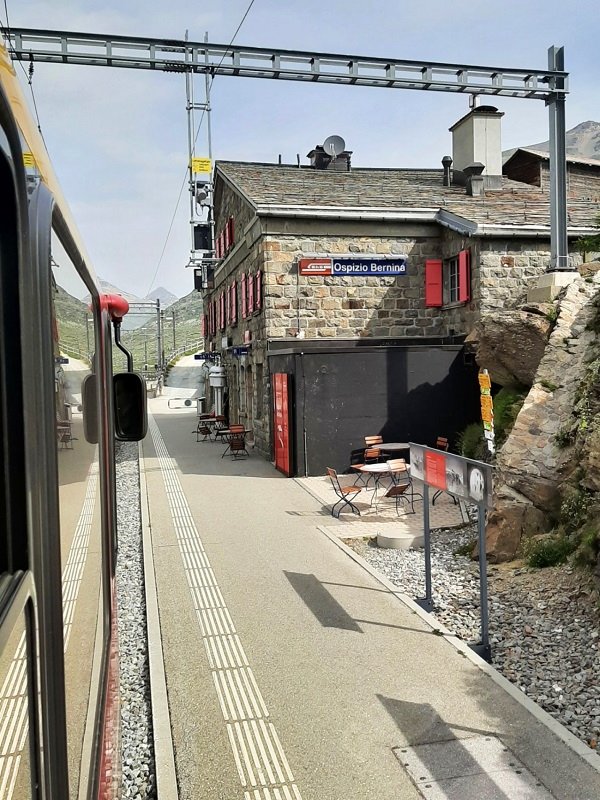


High mountain plateau
The dam located at the northern end of Lago Bianco marks the watershed of the Bernina Pass.
To the south of this dam, the rivers eventually flow into the River Po, while to the north they drain into the basin of the mighty Danube.
Before the railway line starts its descent from the mountain in earnest, there are still a few miles of track on the high mountain plateau of the Bernina Pass to cross.
Even though it was getting quite chilly in the train with the windows on both sides open, I simply loved the wild mountain beauty of this part of the Bernina Railway.

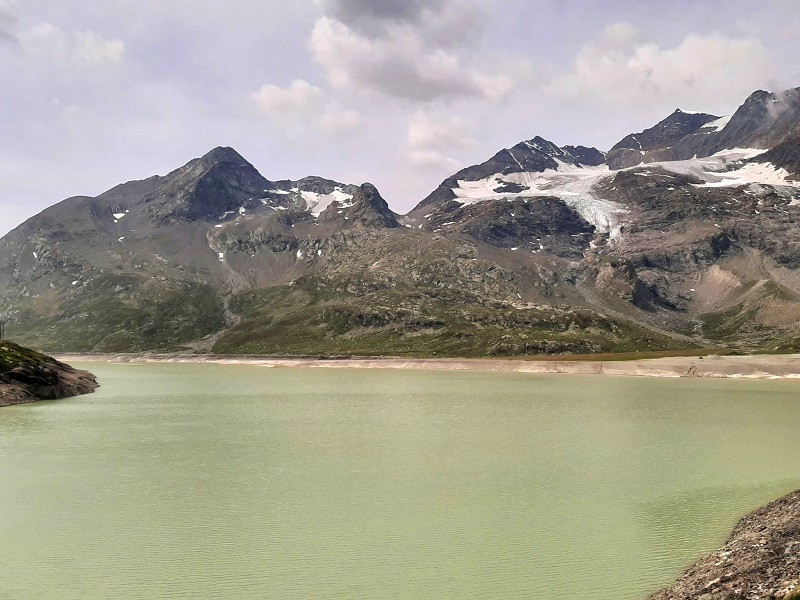


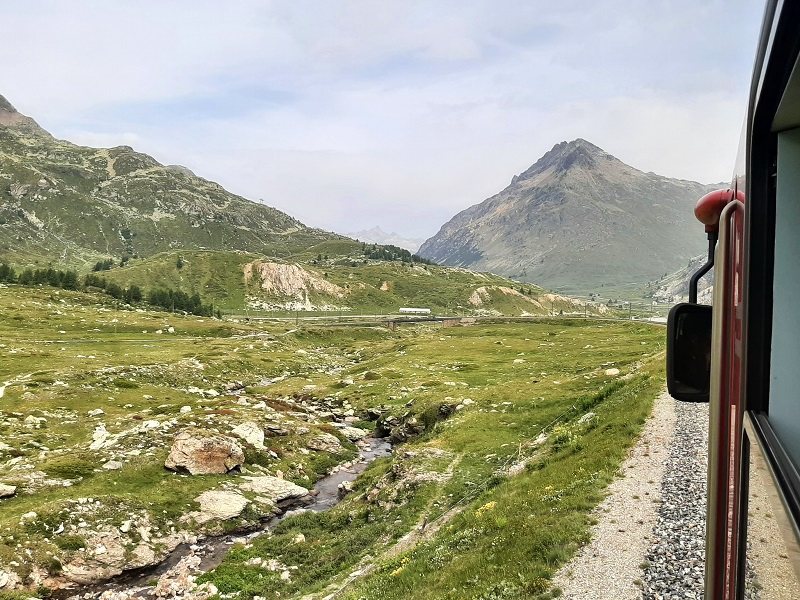






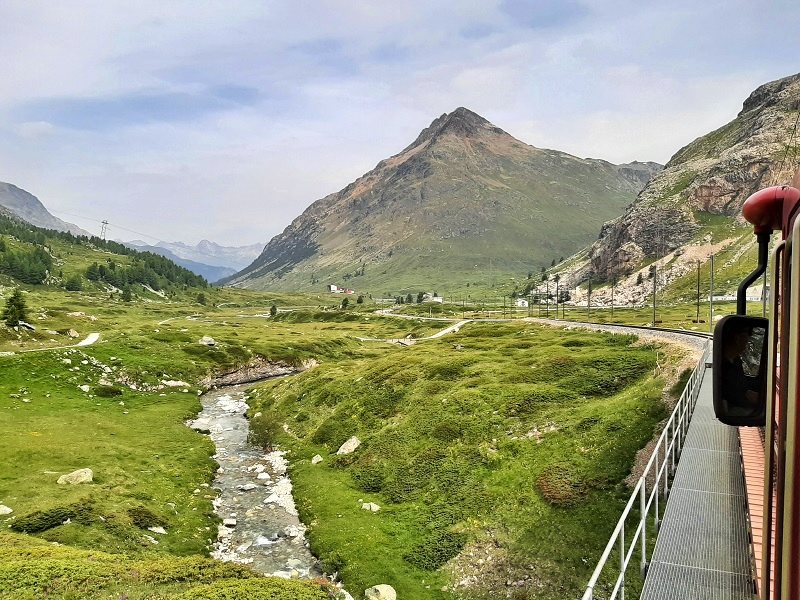


Down the mountain
The journey down the northern slopes of the Bernina Pass towards Pontresina was equally stunning.
Although the railway line runs parallel to the main road for quite a long stretch and the scenery therefore feels less remote, the views are perhaps more sweeping.
You can gaze far into the distance and spot numerous mountain peaks of the Eastern Alps such as Piz Bernina.
From the Bernina Express train you can also clearly spot the Morteratsch Glacier, which looks equally impressive as the towering mountain peaks.
As Pontresina comes into view, you can already spot a few of the town’s castle-like grand hotels scattered along the hillside.
Just moments after our train crossed the Ova de Roseg River, we pulled into the station of Pontresina.
Although the Bernina Railway proper continues for an additional 5 kilometres from Pontresina to its terminus in St. Moritz, our Bernina Express train will instead branch off here, taking the railway line toward Samedan.
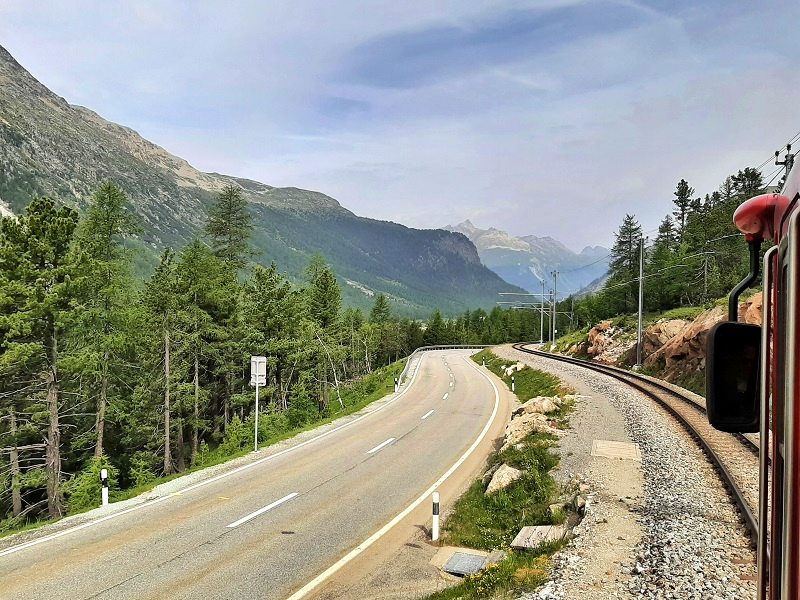
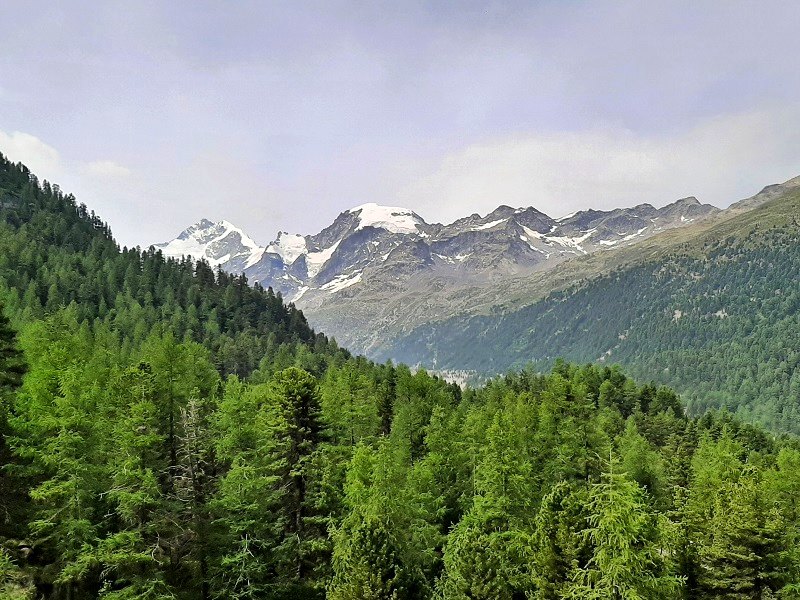

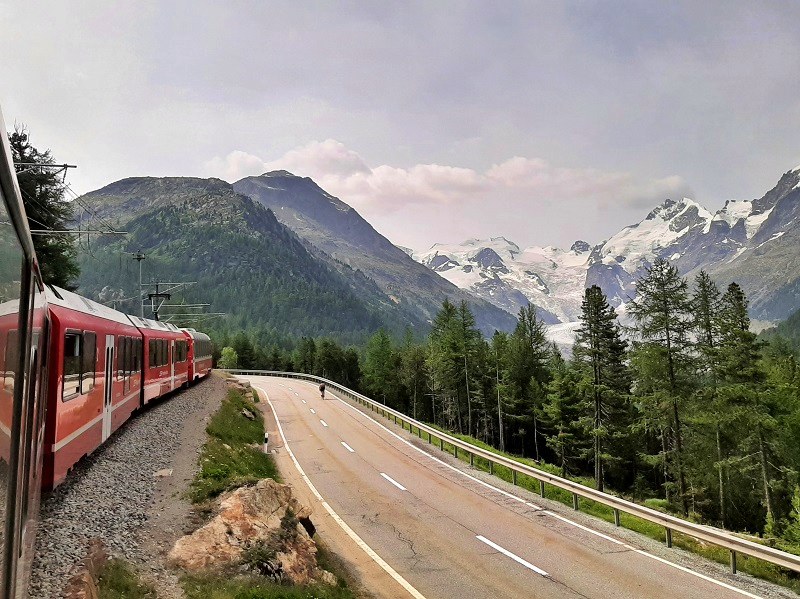
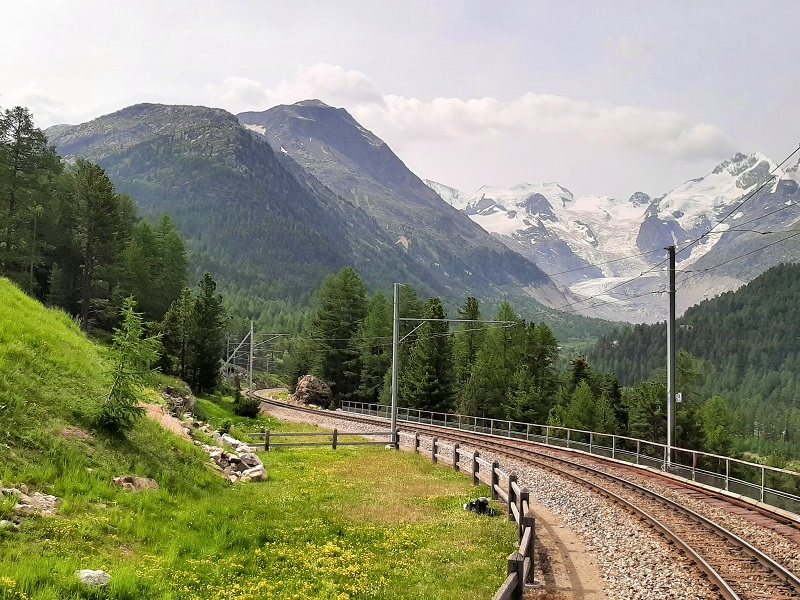
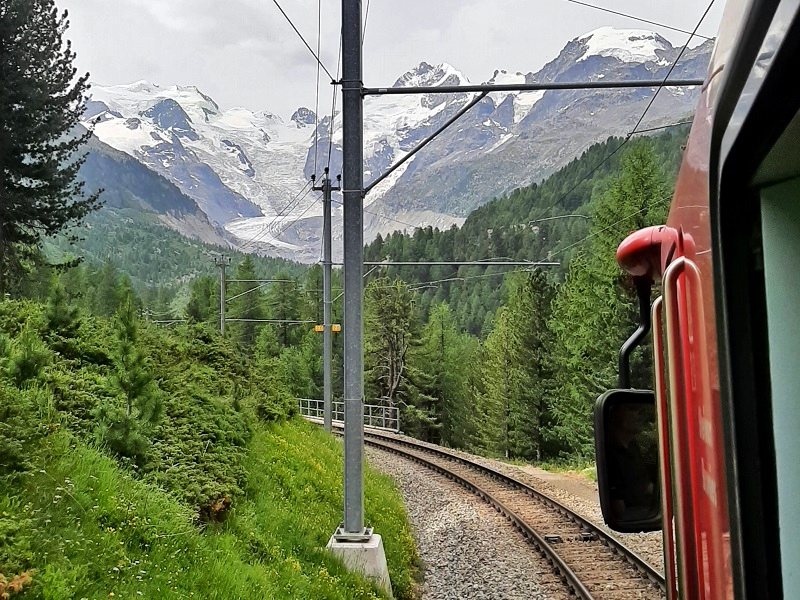

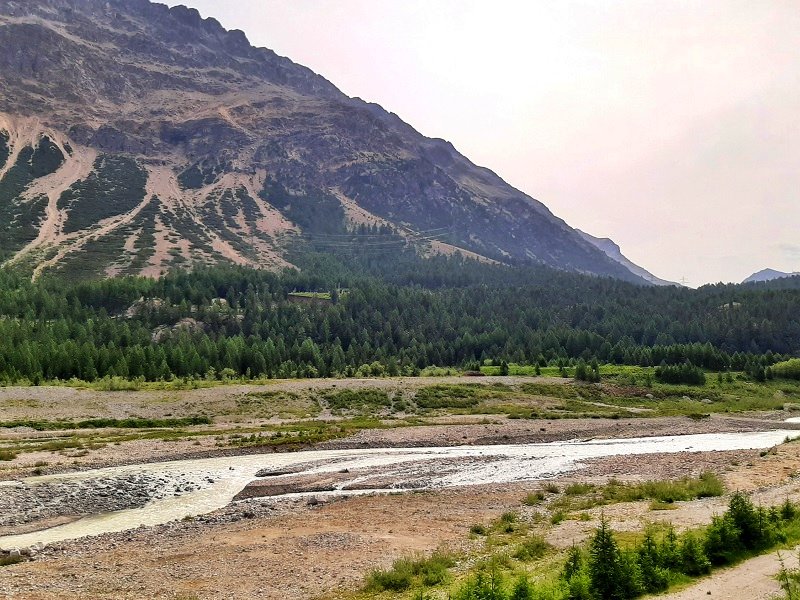
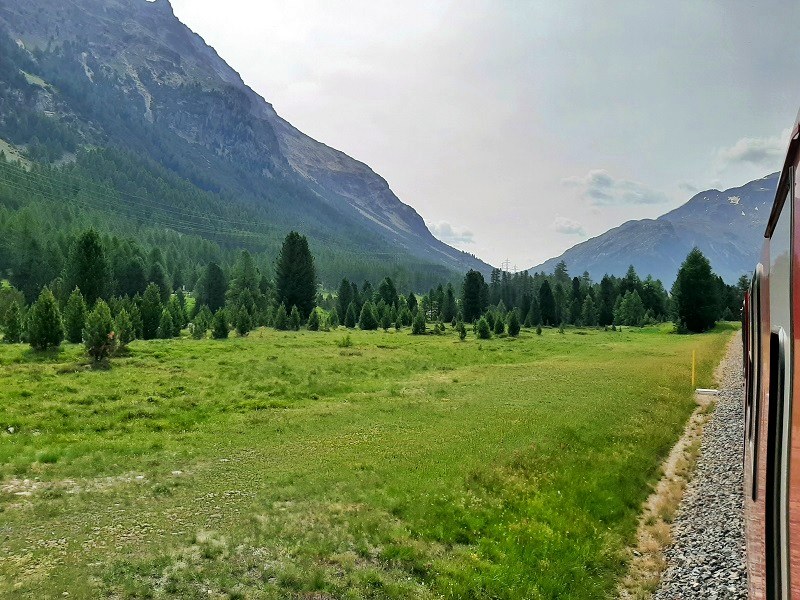

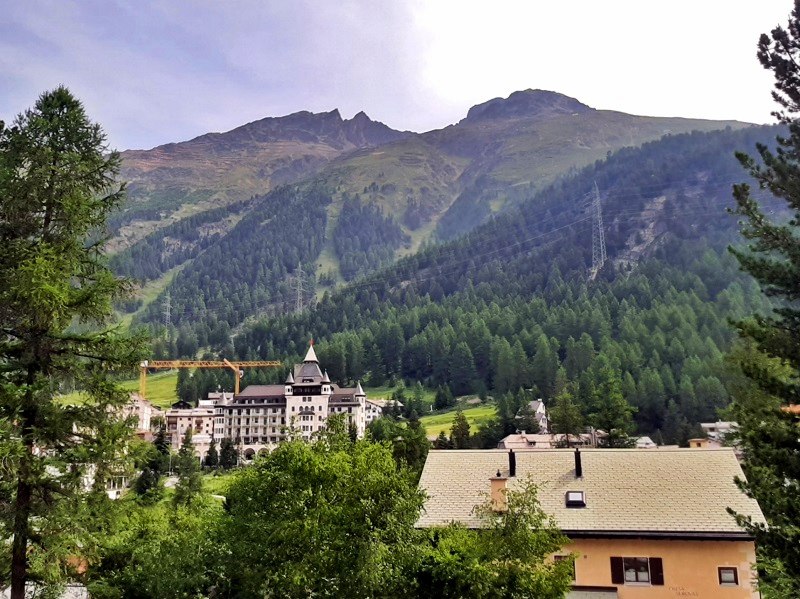


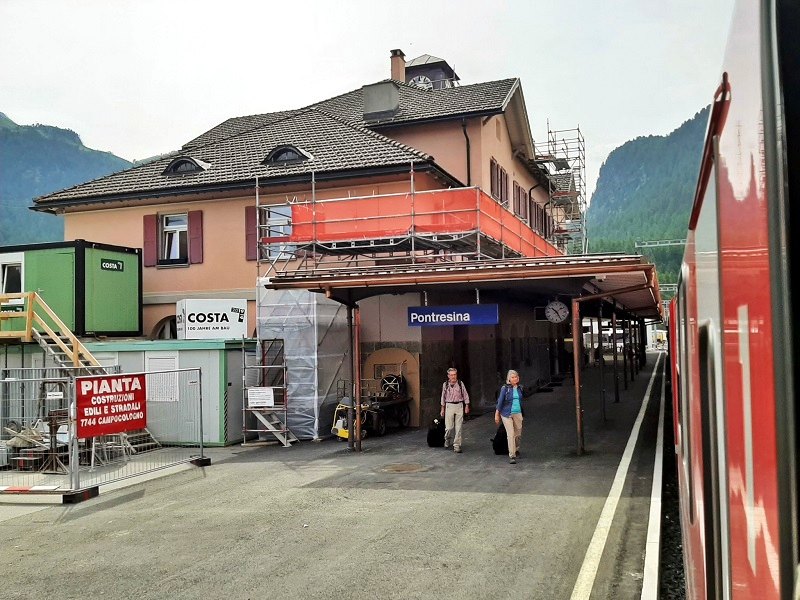
Pontresina to Samedan
In Pontresina, a driver change took place, and unfortunately one of the first things the new driver did was to close the privacy blinds of the cab, so I could no longer look over his shoulder.
Even at this popular stop, the front first-class section of the Allegra railcar remained unoccupied.
This allowed me to continue enjoying the views from both sides of the train, frequently moving from the left side to the right side and back again depending on where the best scenery is.
While the scenery along the Pontresina-Samedan Railway remains appealing, it pales in comparison to the magnificence of the Bernina Pass and the scenery that is yet to come.
It’s the perfect moment to take a breather and perhaps to doze off a bit if you might be tired.
Just before the train arrives in Samedan, you can catch a view of Engadin Airport, which at an elevation of 1,707 metres (5,600 ft) above sea level it is the second highest airport in Europe after Courchevel in France.
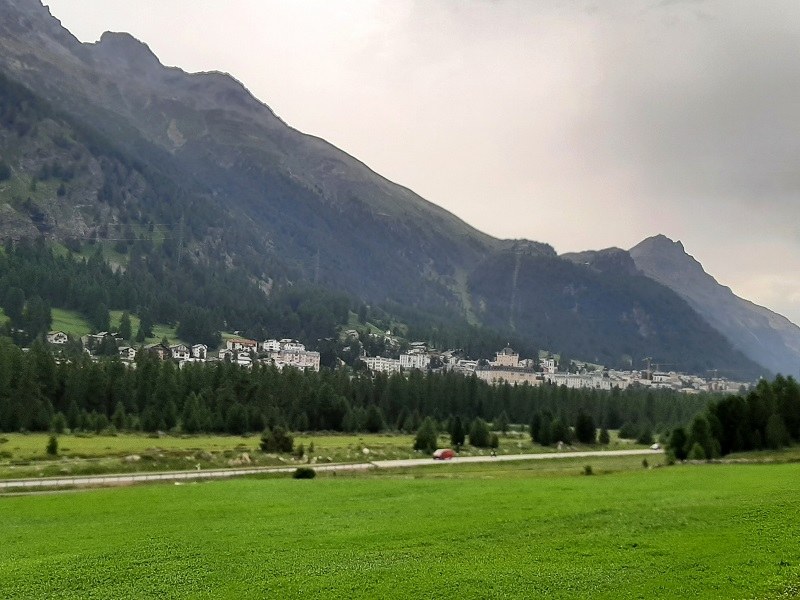

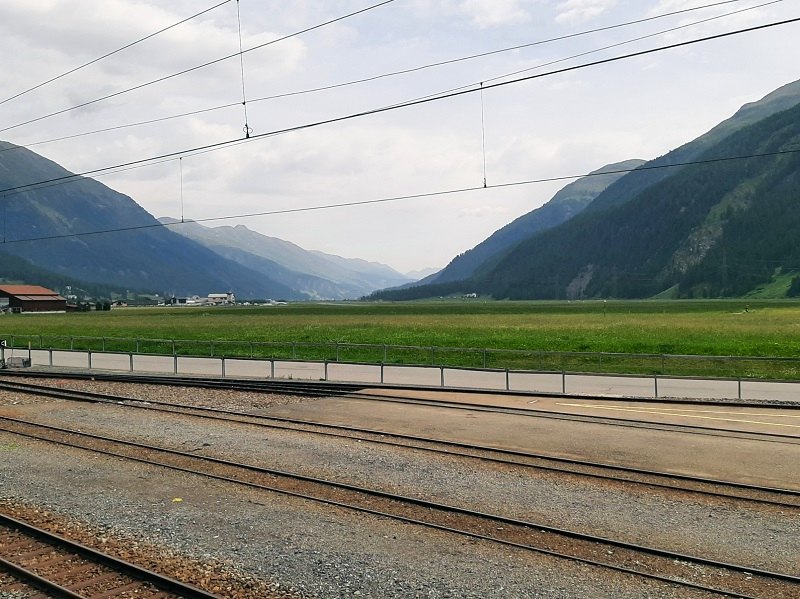
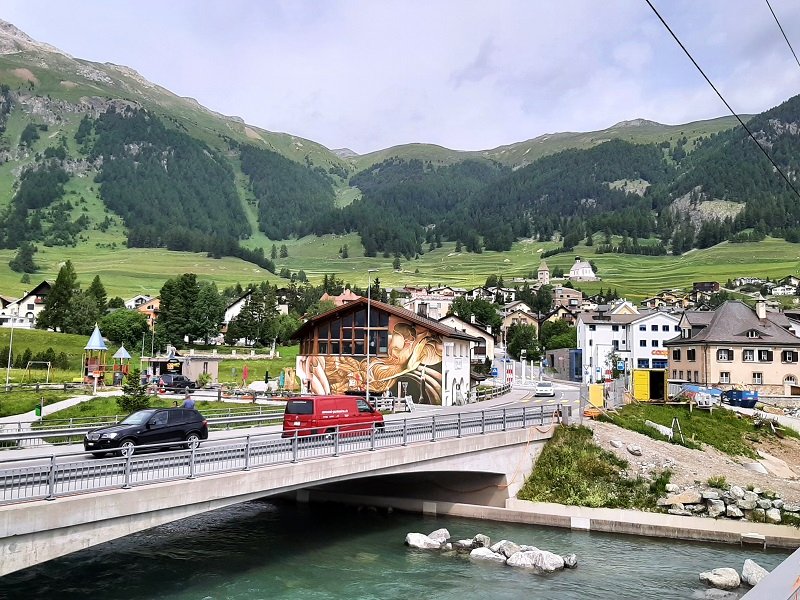

Albula Railway
After the stop in Samedan, the Tirano-Chur Bernina Express heads on the main line through the Engadin Valley towards the village of Bever, where it passes non-stop through the village station and immediately branches off towards the west.
The railway line now follows the course of the River Beverin through a narrow valley and again starts to climb up a bit.
We now found ourselves on the Albula Railway, another scenic line in the network of the Rhaetian Railway.
If you take the Tirano-Chur Bernina Express, you will essentially experience two of Switzerland’s most scenic railway lines: The Bernina Railway and the Albula Railway.
At the village of Spinas, the train enters the 5,865-meter-long (19,242 ft) Albula Tunnel, which leads to Preda in the Albula Valley on the other side of the mountains.
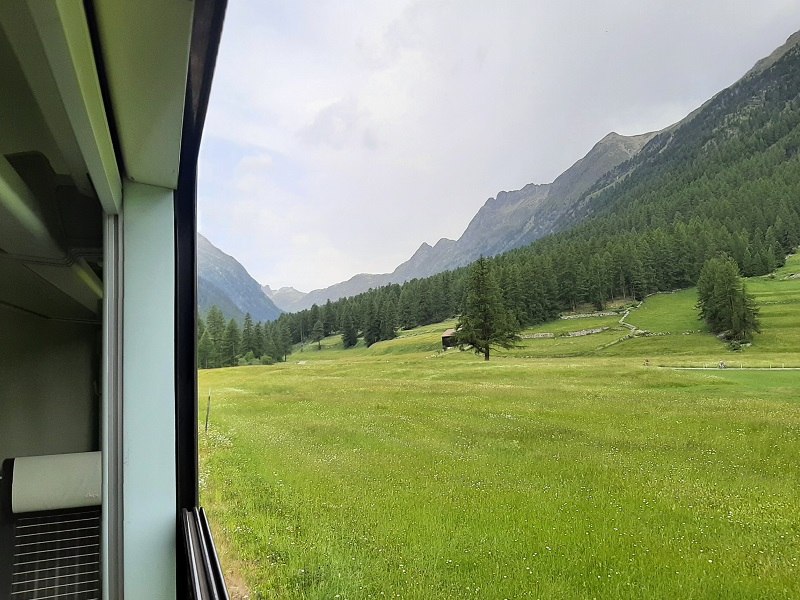

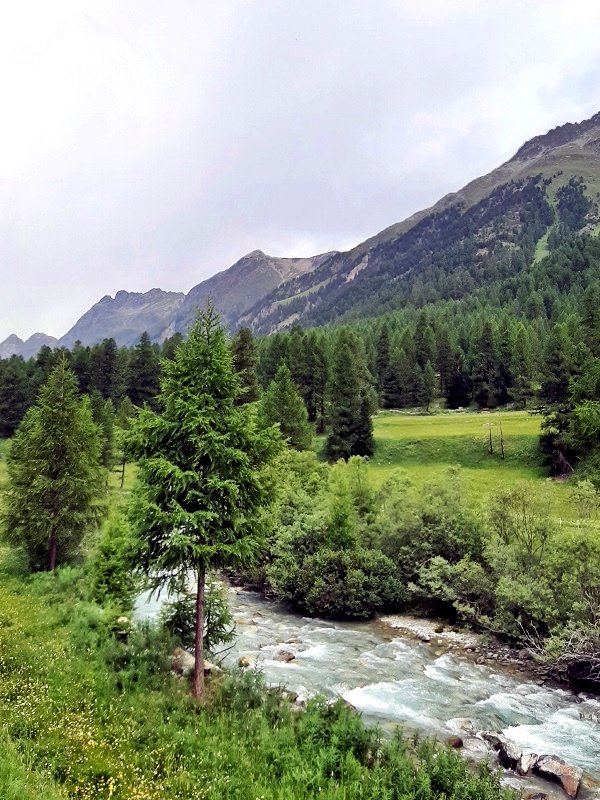



Albula Valley
The railway line through the Albula Valley is yet another highlight when the you take the Bernina Express between Tirano and Chur.
From the moment the Bernina Express train emerges from the Albula Tunnel and enters the valley at Preda all the way down the line to its arrival in the town of Bergün, you are treated not only to some gorgeous mountain views but also to some of Switzerland’s most remarkable feats of railway engineering.
The Albula Railway is famous for its ‘kehrtunnels’ – or spiral tunnels – where the railway line takes a spiralling loop through a tunnel within the mountain, allowing trains to conquer significant changes in elevation while maintaining a manageable gradient on the track.
While the Bernina Express descends the Albula Railway toward Bergün, there are times when you can catch sight of different levels of the railway line through the window.
You can clearly see the sections you’ve recently traversed higher up the mountainside, while the tracks your train has yet to ride are visible a level down in the valley.
At times, it almost feels as if you’re riding a giant model railroad, given the sheer magnificence of the railway line and the picturesque views it offers.
Once we reached the station of Bergün we had to wait again for a train coming from the other direction to pass us.



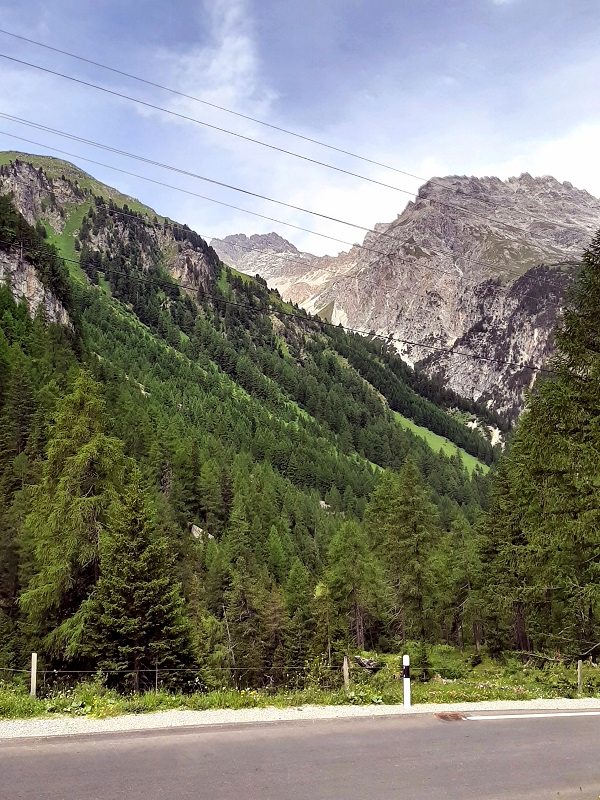
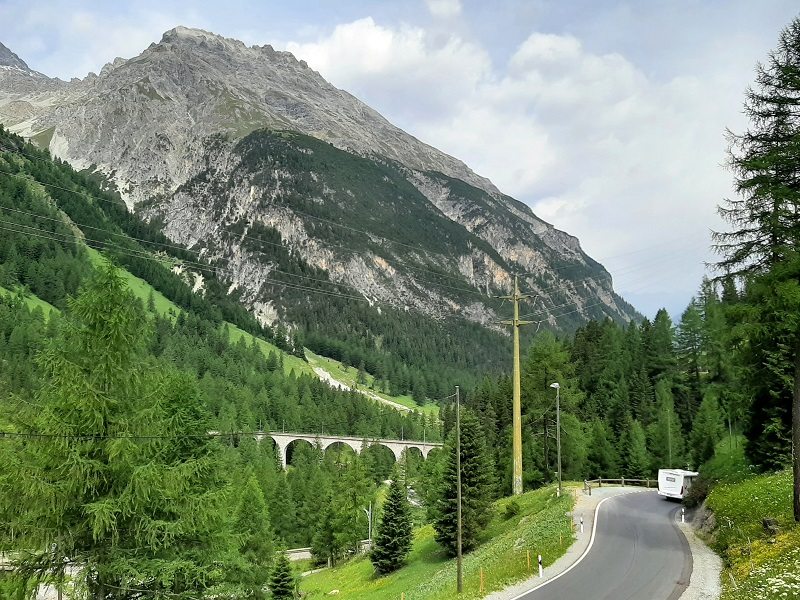
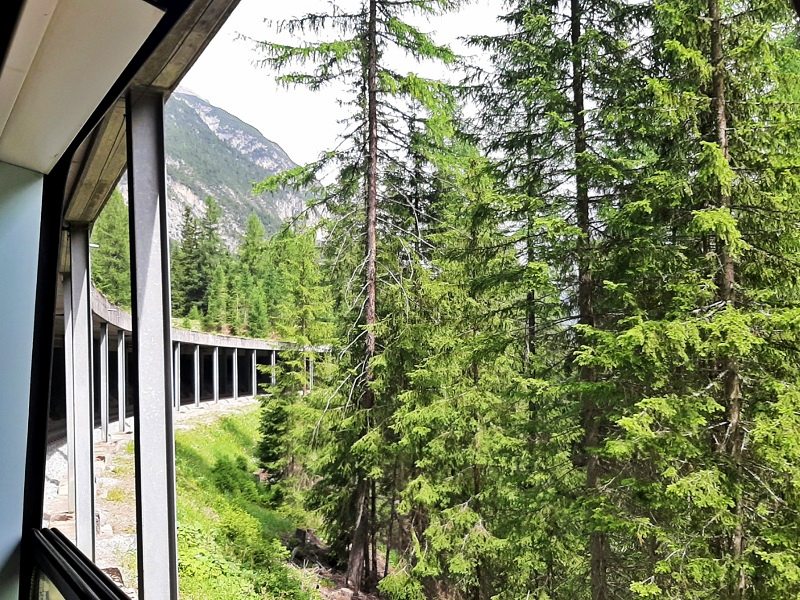


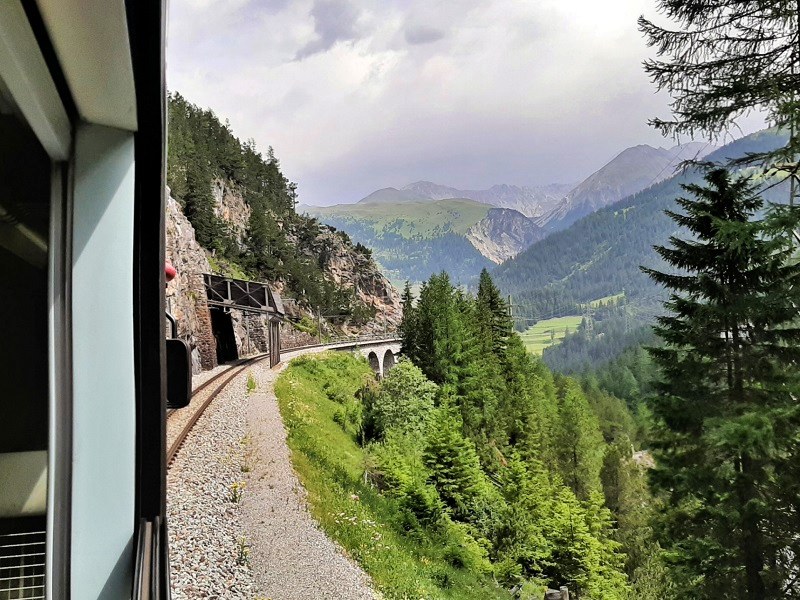


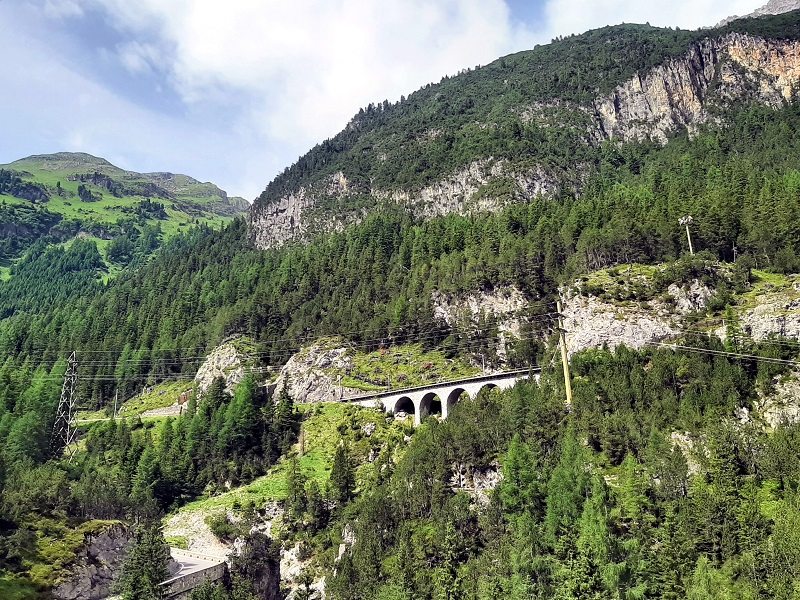





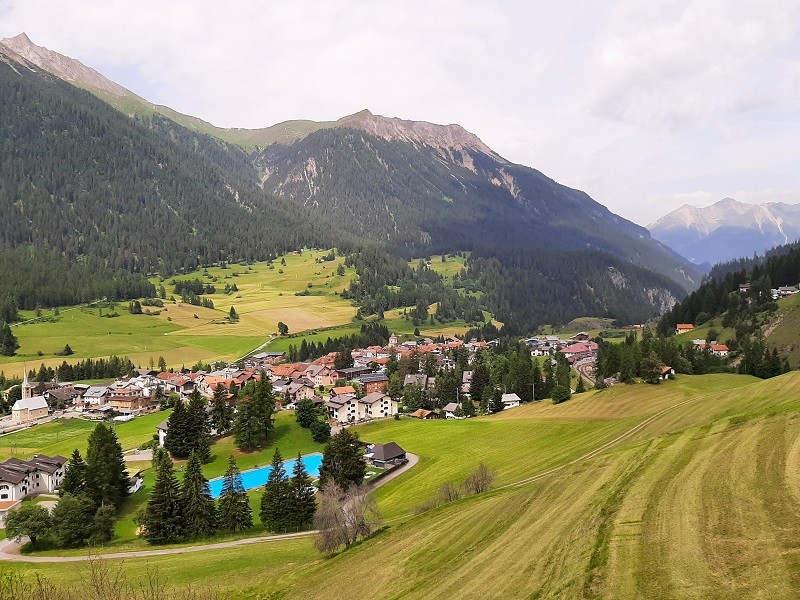


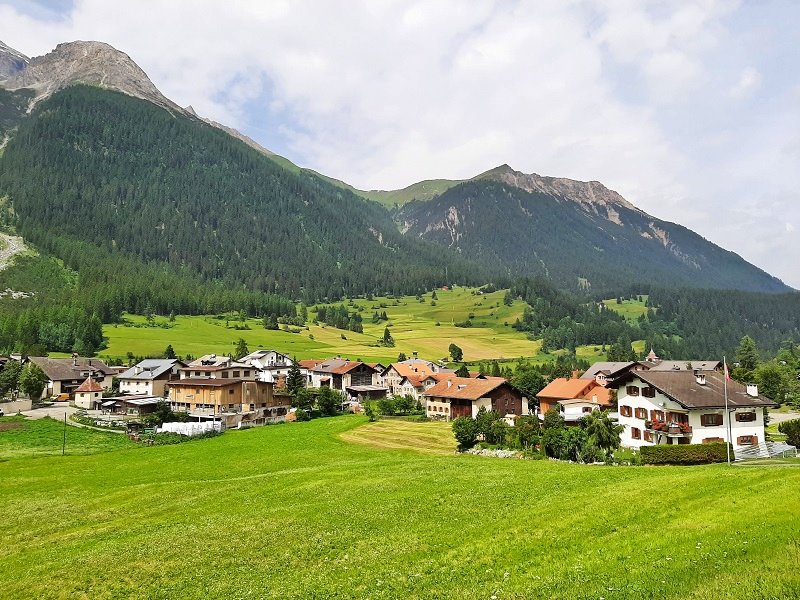


Bergün to Filisur
Between Bergün and Filisur, the Bernina Express descends a further 292 metres down the valley.
While the views from the left side of the train over the valley and the town of Filisur are beautiful, they are soon surpassed by what awaits us after our stop at this station.

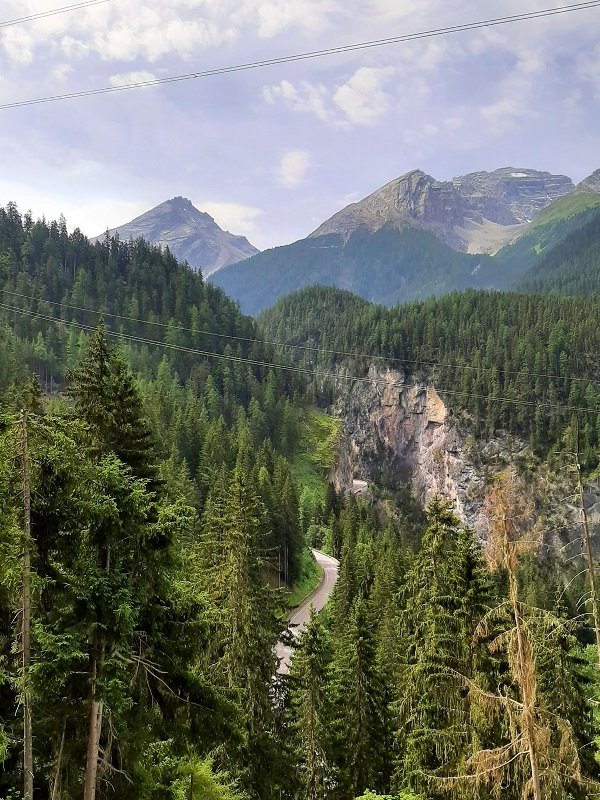

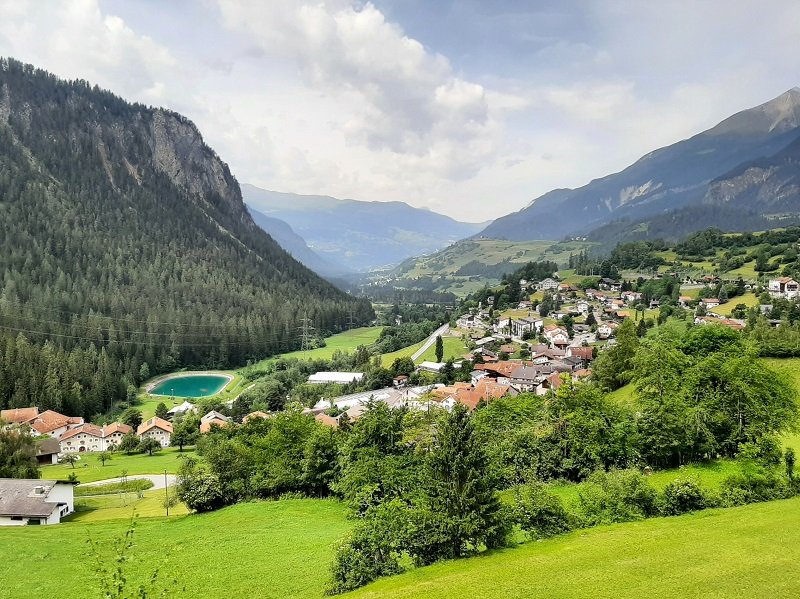

Landwasser Viaduct
Just moments after departure from Filisur, the Bernina Express train will enter a tunnel and by the time it emerges from it will immediately pass over the famous Landwasser Viaduct.
Completed in 1902, the Landwasser Viaduct may very well be the most famous railway bridge in the whole world.
The Landwasser Viaduct consists of six stone arches crafted from limestone, standing at a height of 65 meters (213 ft) and spanning a length of 136 meters (446 ft).
As the Landwasser Viaduct is a curved railway bridge, you can clearly see from the window how the Bernina Express train is crossing this amazing piece of engineering.
Do however make sure you are sitting on the left-hand side of the train when travelling from Tirano to Chur and make sure you have your camera ready, as before you know it you will already be across!
Just after the Landwasser Viaduct, the Bernina Express will cross another beautiful railway bridge called the Schmittentobel Viaduct.
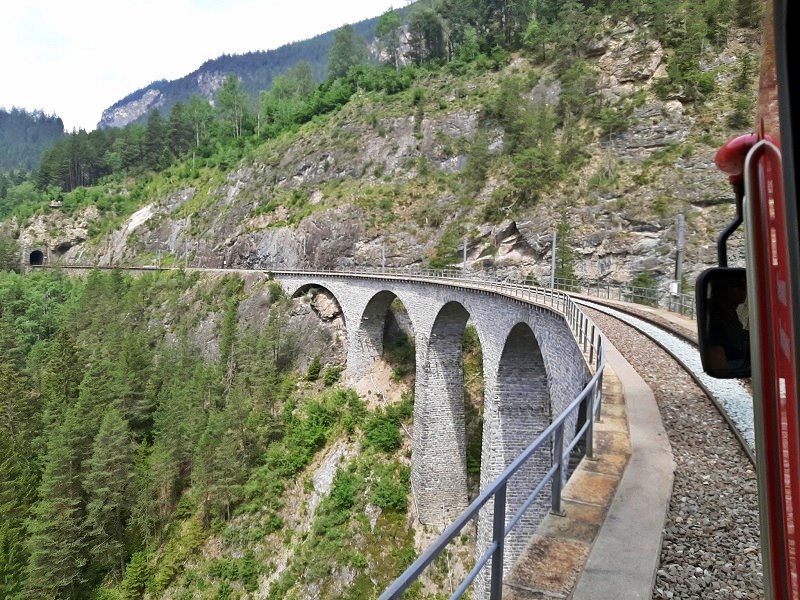


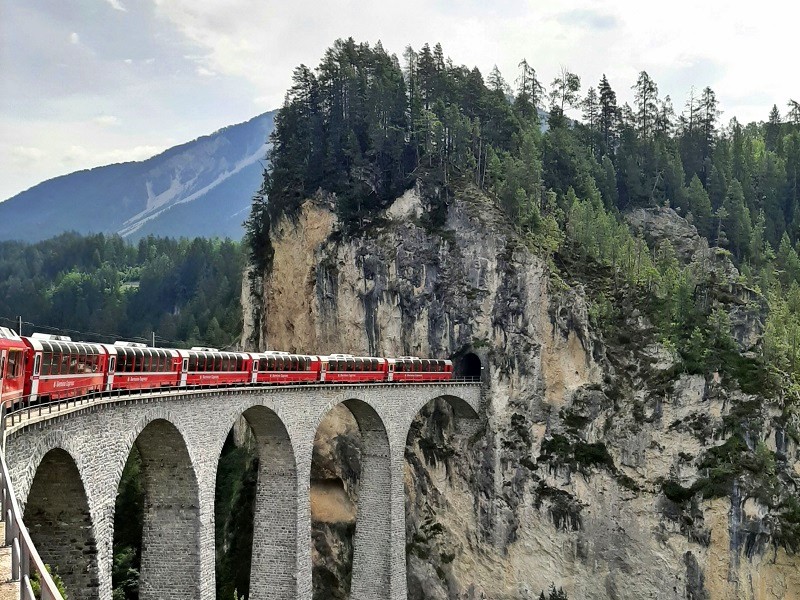
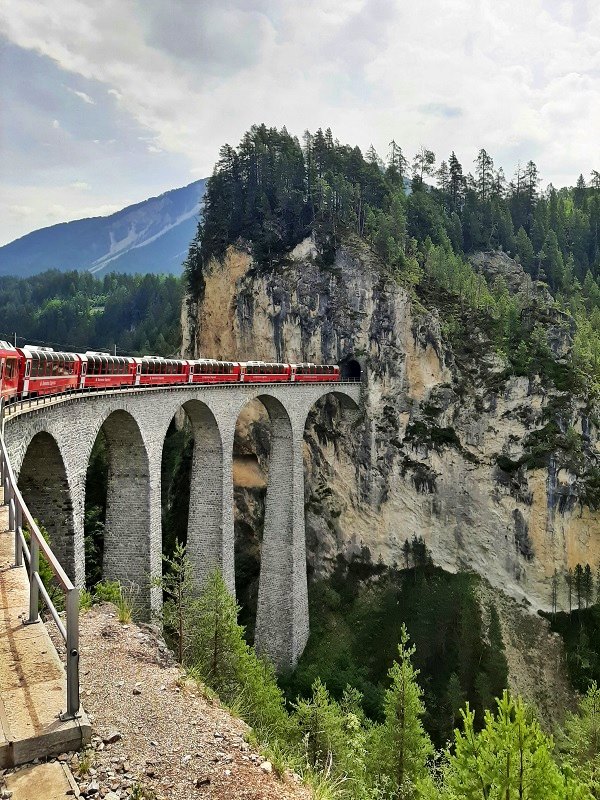




Towards Tiefencastel
Following the Landwasser Viaduct, the Bernina Express train continues through more stunning rural scenery in the Albula Valley.
Especially the view over the village of Surava with its tall church tower is pretty.
Moments later, the train arrived at the Tiefencastel station, where a bright yellow PostBus was waiting to collect passengers who were getting off.
Switzerland really has a superb transport network and whether you are connecting at a station to another train or to a bus, you’ll find that all the timetables are integrated, allowing for quick and seamless transfers.
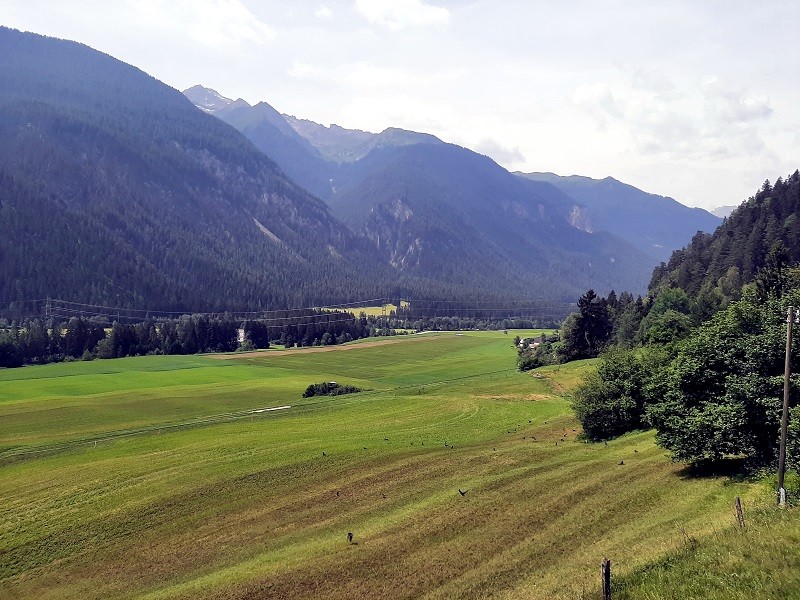
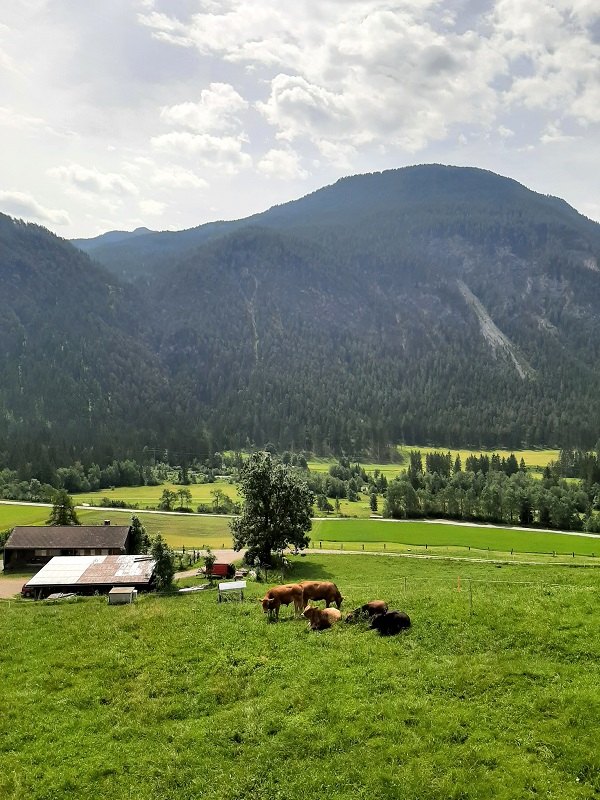






Tiefencastel to Thusis
Between Tiefencastel and Thusis, the Albula Valley seems to narrow and the railway line passes through some canyon-like surroundings.
Here, the Albula River is dammed, creating the Solis Reservoir, of which the water is used by a hydroelectric power plant for energy production.
At the western end of the reservoir, the Albula Railway runs across the Solis Viaduct.
Constructed in 1902 from limestone, the Solis Viaduct stands at a height of 89 meters (292 ft) and spans a length of 164 meters (538 ft), featuring a central arch that stretches 42 meters (138 ft) across.
Although you cannot really see the railway viaduct when you ride across it on the Bernina Express, the view down into the deep canyon is for sure impressive.
On both sides of the train, you can however spot a road bridge over the same river canyon, with the old stone bridge on the left being the most picturesque.
Shortly before reaching Thusis, the Albula Railway crosses a bridge over the Hinterrhein (Posterior Rhine), one of the two initial tributaries of the mighty Rhine.








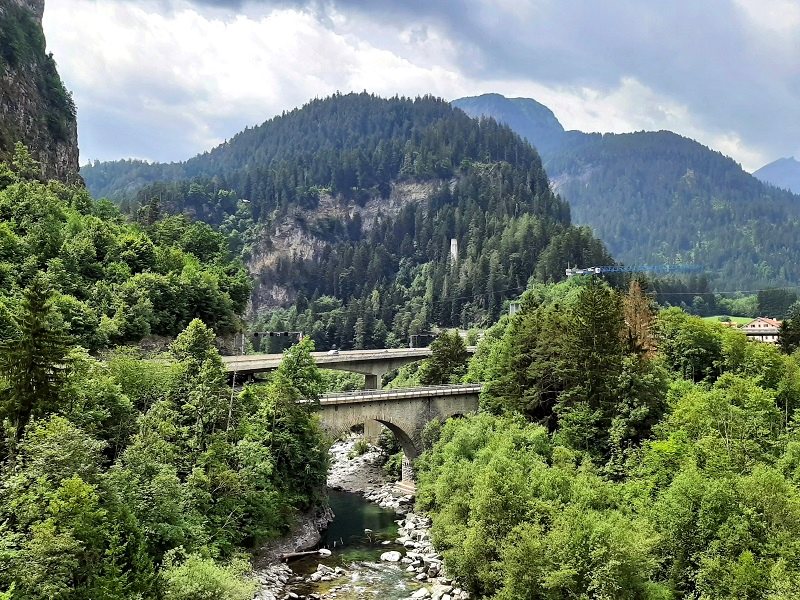


Along the Rhine
Just after departure from Thusis, it started to rain and I was forced to close the windows of the train.
My Bernina Express journey once again proved how quickly the weather can change in the Alps.
I began in Tirano with clear skies but ended the train trip to Chur with rain and dark clouds for the last few miles.
Even though we were now only half an hour away from Chur, there were still some stunning sights to see from the train window.
Between Thusis and Reichenau, the railway line runs directly along the Hinterrhein.
On your right-hand side you can spot Schloss Ortenstein, a castle with a stunning location on a rocky outcrop high above the river.
As the Bernina Express nears the town of Reichenau and crosses a bridge spanning the Hinterrhein, you can see on your left-hand side the confluence of this river with the Vorderrhein (Anterior Rhine), giving rise to the formation of the River Rhine.
There really isn’t a dull moment during the long train journey on the Bernina Express from Tirano to Chur!
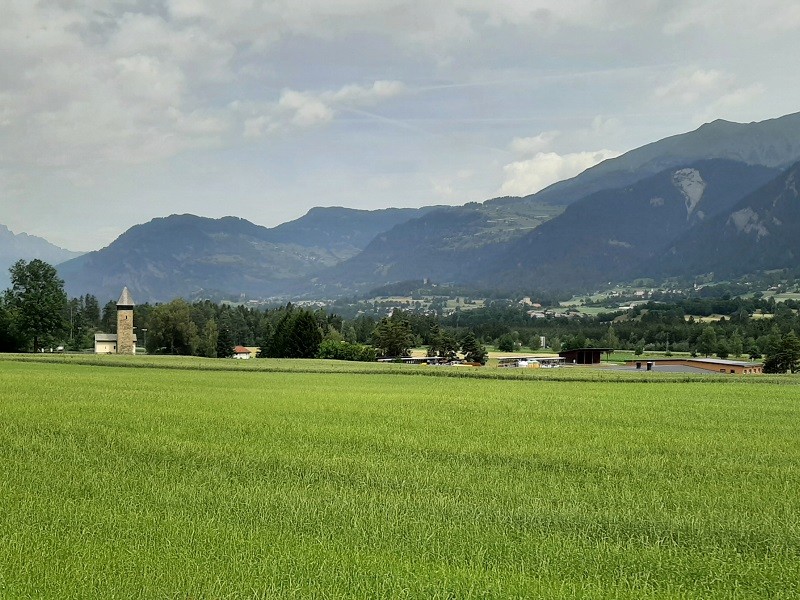



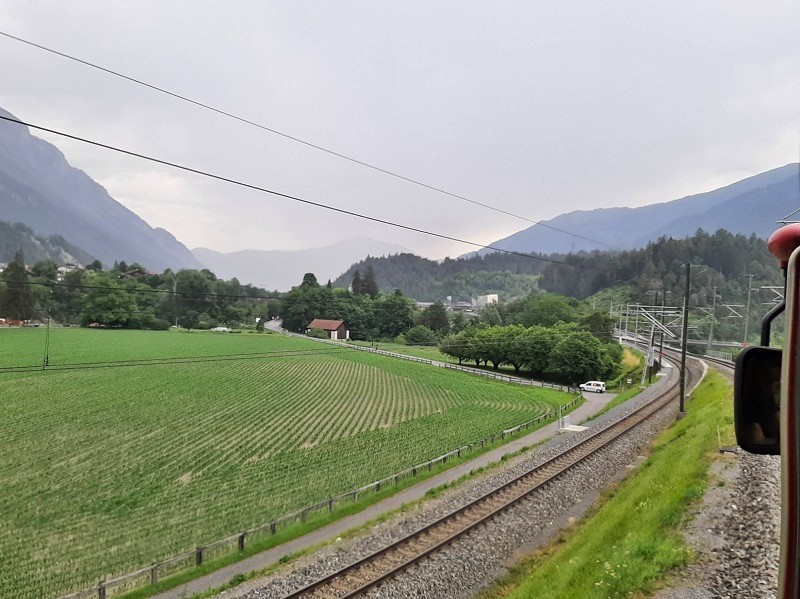
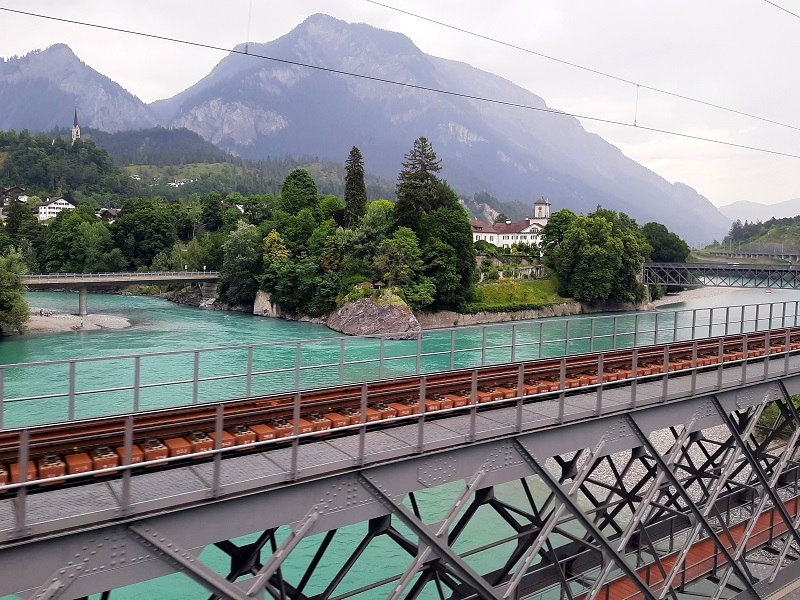


Final stretch to Chur
Our train passed non-stop through the station of Reichenau and continued its journey along the banks of the Rhine.
Eventually, the outskirts of Chur, the capital and largest city of the Swiss Canton of Grisons, came into sight.
The Bernina Express pulled into the train station of Chur precisely four-and-a-half hours after it commenced its journey in Tirano, being bang on time.
At Chur, you can change trains to destinations such as Bern, Zurich, Basel, Arosa and Andermatt.
I was connecting myself to a Chur-Zurich Intercity train, which was an easy same-platform change.
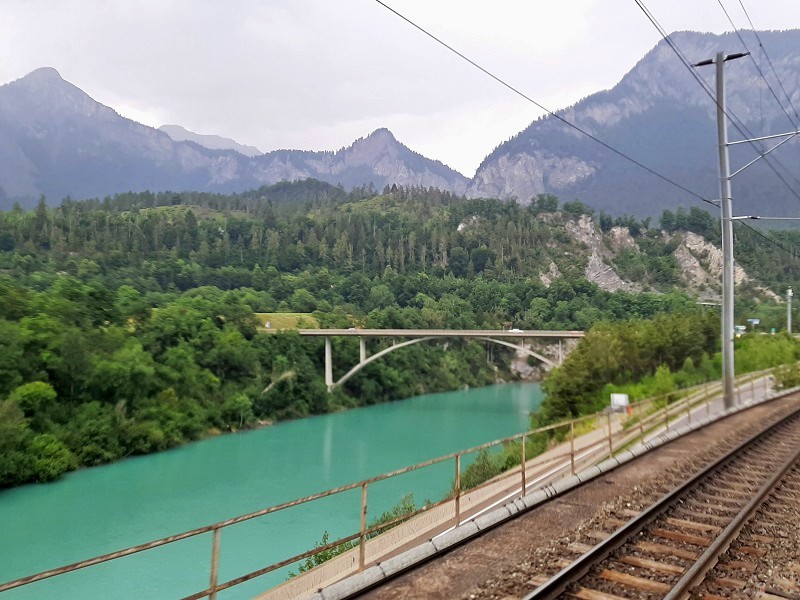
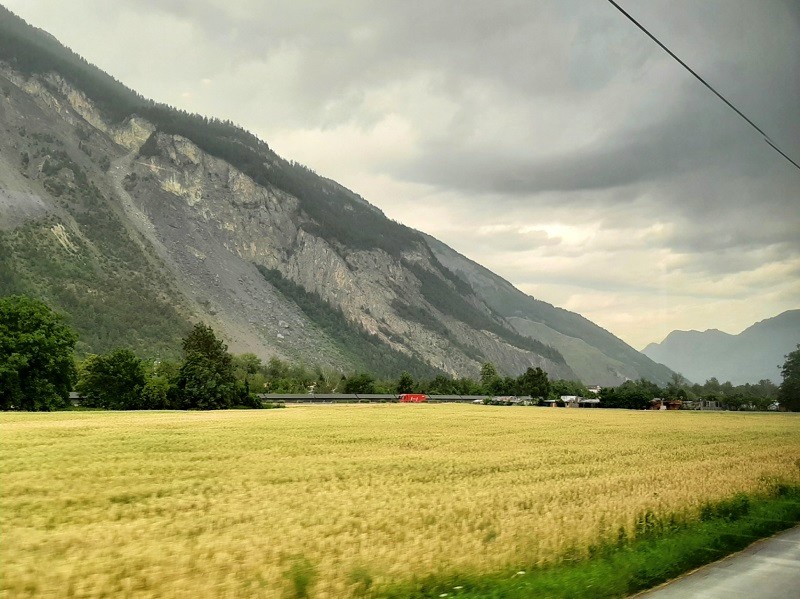

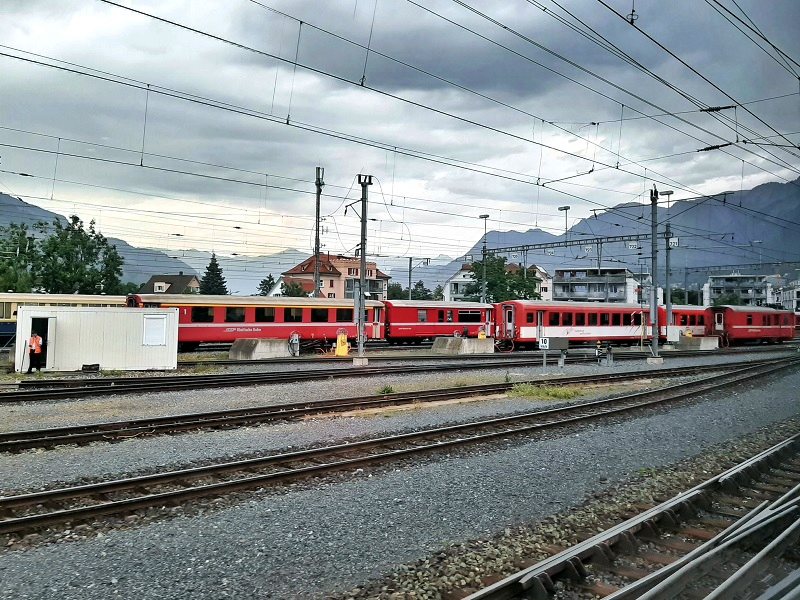

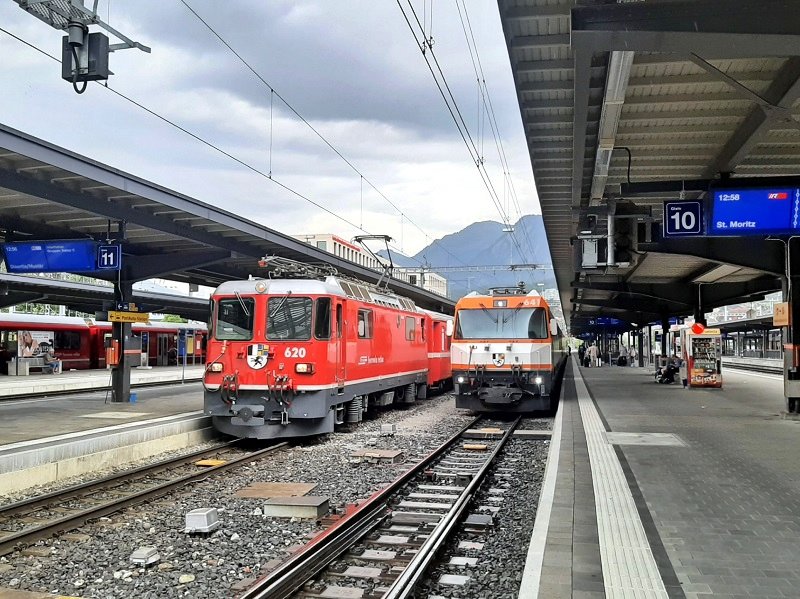


Bernina Express FAQ
Before I draw my final conclusions about the Bernina Express, let’s have a quick look at some frequently asked questions about this iconic Swiss train.
Where can I buy a ticket for the Bernina Express?
It’s easy to buy your ticket for the Bernina Express or one of the local trains on the website of the Rhätische Bahn (RhB, Rhaetian Railway) or the Swiss Federal Railways (SBB), as well as any train station in Switzerland and even some international ticket offices in other European countries.
On both website you can buy connecting tickets as well, so if you might start your journey in Zurich or somewhere else in Switzerland, it’s easy to buy a ticket for both the Bernina Express train and your connecting train in one transaction.
However, be careful when booking a ticket through the Swiss Federal Railways, as their website will automatically assume you possess a half fare travelcard (‘halbtax’), which grants a 50% discount and is held by most Swiss people.
If you’re planning to travel extensively by train in Switzerland, it might be worth buying such a half fare travelcard, but if not, make sure that the ticket you purchase is the full price one and not a 50% discounted one.
Second class tickets for the Bernina Express between Chur and Tirano start at 52 CHF (€54), while the train journey between St. Moritz and Tirano starts at 32 CHF (€33) for a second class ticket.
Local trains can even be slightly cheaper if you manage to book an advance saver fare.
Remember that if you want a seat in the panorama wagon of the Bernina Express, you must pay extra for the seat reservation on top of your ticket, which can be done as well through the Rhätische Bahn website.
Although tickets for the Bernina Express and local trains can never sell out (as you can always use the trainsets with unreserved seating) the reserved seats in the panorama carriages can sell out, which regularly happens during the high season.
You don’t have to buy the seat reservation and your ticket in the same transaction as they can be bought separately.

How can I reserve a seat in the panorama carriage of the Bernina Express?
Seat reservations for the Bernina Express can be made online through the Rhätische Bahn website, by telephone or at any train station ticket office in Switzerland (as well as some booking offices of train stations abroad), at earliest three months before your date of travel.
The cost of a seat reservation will vary depending on the season of your travel, ranging between 26 CHF (€27) and 20 CHF (€21).
Even though you can reserve a window seat in one of the panorama carriages of the Bernina Express, it’s not possible to specify whether you’ll be seated on the left or right side of the train, or whether you’ll face forward or backward in the direction of travel.
This is because it’s not known in advance which way round each carriage will run as this depends on the marshalling process.
Of course, if you aren’t happy with your assigned seat you can always move into an empty seat if you find one available.

Is the Interrail and Eurail pass valid on the Bernina Express?
Both Interrail and Eurail train passes are accepted on the Bernina Express, as well as on all the local train services operated by the Rhaetian Railway.
Only if you want to use the panorama wagons of the Bernina Express, you have to pay a seat reservation supplement, as explained above.
Given the high prices of train travel in Switzerland, using an rail pass can certainly make a lot of sense if you intend to travel a lot by train through the country.
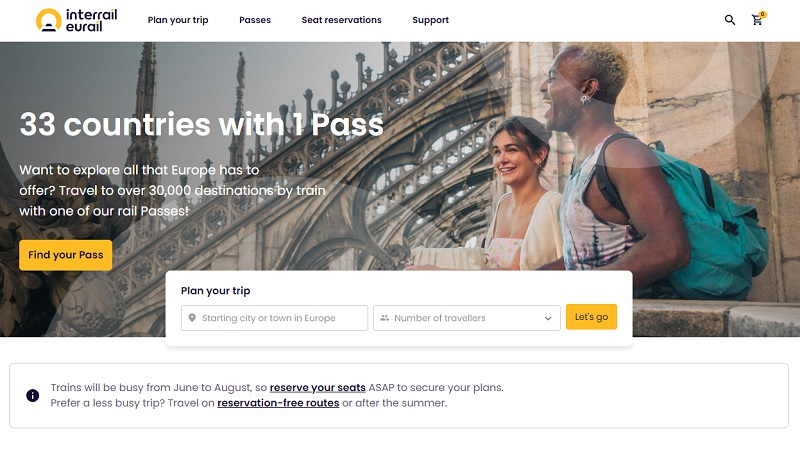
Is the Swiss Saver Day Pass valid on the Bernina Express?
If you plan to buy a Swiss Saver Day Pass, you can also use it for any train on the Bernina Railway, including the Bernina Express.
Multiple-day rail passes such as the Swiss Travel Pass are also valid.
The Swiss Saver Day Pass, which you can buy in both 2nd and 1st class, gives you a day’s unlimited travel on almost all trains, trams, buses and boats that compromise the public transport network of Switzerland.
The Swiss Saver Day Pass is often the cheapest option if you want to combine the Bernina Express with another train trip on the same day, for example if you are starting the day from Zurich and also need to take the Zurich-Chur train to connect to the Bernina Express.
You can buy a Swiss Saver Day Pass online at the website of the Swiss Federal Railways,
A Swiss Saver Day Pass starts at 52 CHF (€54) in second class and 88 CHF (€92) in first class buy them well in advance, but get progressively more expensive if you buy them closer to your date of travel.

Can you book cheaper Bernina Express on the German Railways website?
You can sometimes book cheaper Bernina Express tickets through the website of the German Railways.
The Germans sometimes have special saver fares from cities in Germany close to the Swiss border such as Freiburg or Singen to Tirano, with prices starting from €29.90 if you book far in advance.
These saver fares are called ‘Super Sparpreis Europa’ or ‘Sparpreis Europa’ and they exist the other way around too from Tirano to Germany.
The trick is to click on ‘stopover’ in the German Railways search engine and to put the station of Chur in the ‘via’ box, as this ensures that the options shown are all on trains across the Bernina Railway.
Unlike airplanes, there’s no requirement to ensure you take all the trains listed on the ticket, which means you can buy such a ticket from Germany to Italy even if your intention is to travel only from Chur to Tirano on the Bernina Express!
Sadly, the €29.90 saver tickets are increasingly hard to find as the cheapest fare buckets are often zeroed out.
This is why you most often will only find slightly more expensive Sparpreis Europa tickets starting at €49.90 in second class and €59.90 in first class.
As you can see, if you plan to travel in second class, there is no great value anymore as you are perhaps better off buying a Swiss Saver Day Pass, which is more or less the same price as a German Sparpreis ticket but does give you unlimited travel for one day and all the flexibility that comes with it.
The difference between first class prices is greater, so a German Sparpreis ticket for first class can save you quite a bit more if you opt for this travel class.
However, be warned that unlike a Saver Day Pass these German saver tickets are valid for train-specific travel only, so you must take the Bernina Express train listed on your actual itinerary and don’t have the freedom to take an earlier or later train.
Of course, if your intention is to travel from Germany to Tirano (or vice versa) using the Bernina Express along with connecting trains, it’s advisable to purchase your ticket through the German Railways website.
This approach is likely to offer the best price and the convenience of having all your trains covered under a single ticket.

How are onward connections in Tirano?
The narrow-gauge Rhaetian Railway station which the Bernina Express uses in Tirano is located directly next to the standard-gauge station of the Italian railways.
When connecting to or from the Bernina Express in Tirano to destinations in Italy such as Milan, you can use the Trenord or Trenitalia website to buy your Italian train ticket, or simply do so at the station.
Since you’re purchasing separate tickets, it’s recommended to allocate sufficient time for your connection in Tirano as the trains won’t wait for each other in case one of them has a delay.
It’s also possible to take a Bernina Express Bus between Tirano and Locarno in combination with the train, which can be booked as one combined ticket on the Rhaetian Railway website.

Are stopovers allowed on the Bernina Express?
If you have paid a full-price ticket or are travelling with an Interrail, Eurail or Swiss Saver Day Pass, you can technically make as many stopovers you want along the length of the Bernina Railway.
For example, you can get off the train at Alp Grüm to hike a bit, and then take any later train departure to continue your route.
However, keep in mind that a Saver Day Pass and full price ticket are valid on a specific day only, so your stopover along the route cannot be overnight.
If you have bought a saver fare for the Bernina Express or one of the local trains along the Bernina Railway, it must be used on the specific train you bought your ticket for, so in this case you cannot stop over somewhere along the route.
Seat reservations in the panorama carriage are always tied to a specific train only, so if you decide to make a stopover and wish to use the panorama carriage on a later train, you’ll need to pay for the reservation again.

On which side of the Bernina Express train should you sit?
While the Bernina Express offers a breathtaking view from both sides of the train, it’s the left-hand side (when traveling northbound from Tirano to St. Moritz or Chur, so the right-hand side when traveling south) that arguably provides the most stunning views.
If possible, I highly recommend choosing a seat on that side, as it offers the best views of some of the most famous sights along the Bernina Express route, including the Brusio Spiral Viaduct, Landwasser Viaduct, Palü Glacier and Lago Bianco.

Conclusion
A trip on the Bernina Express makes for one of the world’s most epic train journeys as you’ll be treated to four hours of amazing scenery.
From Tirano to Chur, the Bernina Express offers a continuous display of breathtaking mountain views and impressive railway engineering feats.
On the Bernina Railway, you will traverse the famous Brusio Spiral Viaduct, ride alongside Lake Poschiavo, see stunning Lake Palü and the Palü Glacier at Alp Grüm and cross the Bernina Pass while enjoying some fine views over the peaks of the Eastern Alps and the Morteratsch Glacier.
The Tirano-Chur Bernina Express also traverses the Albula Railway, which is well-known for its multiple spiral loop tunnels and its arched bridges such as the famous Landwasser Viaduct.
Whether you opt for a seat in the panorama carriage of the Bernina Express, the Allegra railcar with its opening windows, or go for one of the slower local train services, you’ll be in for an unforgettable journey.
Trip report index
This article is part of the ‘Scenic Trains Around Switzerland and the Italian Lakes‘ trip report, which consists of the following chapters:
1. Bergamo: A Visit to Lombardy’s Beautiful Hilltop Town
2. Travelling From Bergamo to Milan by Train
3. From Milan to Varenna and Tirano By Trenord Regional Train
4. A Varenna Visit: A Day Trip to Lake Como’s Most Beautiful Town
5. Tirano: The Italian Gateway to the Bernina Railway
6. Bernina Express Train: Guide to Switzerland’s Most Scenic Railway (current chapter)
7. Review: Swiss InterCity (IC) Train Chur to Zurich and Basel
8. From Zurich to Geneva on a Swiss ICN Tilting Train
9. Cheap Geneva Hotel: Stay Across the Border in Annemasse!
10. Around Lake Geneva by Train: From Geneva to Montreux
11. A Visit to Montreux and the Freddie Mercury Statue
12. Golden Pass: Guide to a Scenic Railway Route Across Switzerland
13. Swiss Chique: The MOB GoldenPass Belle Époque Train
14. From the Mountains to the Lake: Zweisimmen to Spiez by Train
15. Spectacular Spiez: A Visit to a Scenic Swiss Town
16. Spiez to Interlaken by Train: A Trip on the Lake Thun Railway Line
17. Review: Interlaken to Lucerne by Zentralbahn Train
18. Lucerne: Exploring One of Switzerland’s Most Beautiful Cities
19. From Lucerne to Locarno: By Train Across the Gotthard
20. A Visit to Locarno and the Sanctuary of Madonna del Sasso
21. Centovalli Railway: By Train From Locarno to Domodossola
22. Stresa: Grand Hotels, Lakeside Views, and the Borromean Islands
23. Review: Trenitalia Frecciarossa High-Speed Train Milan to Bologna


This was an amazing report. Glad I read it, Bernina is now on my bucketlist. Thank you